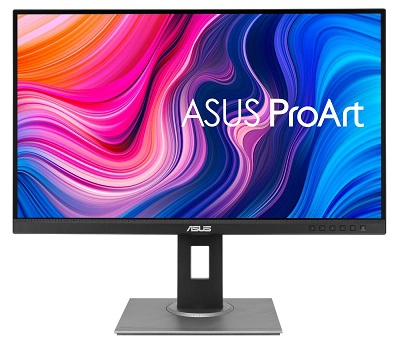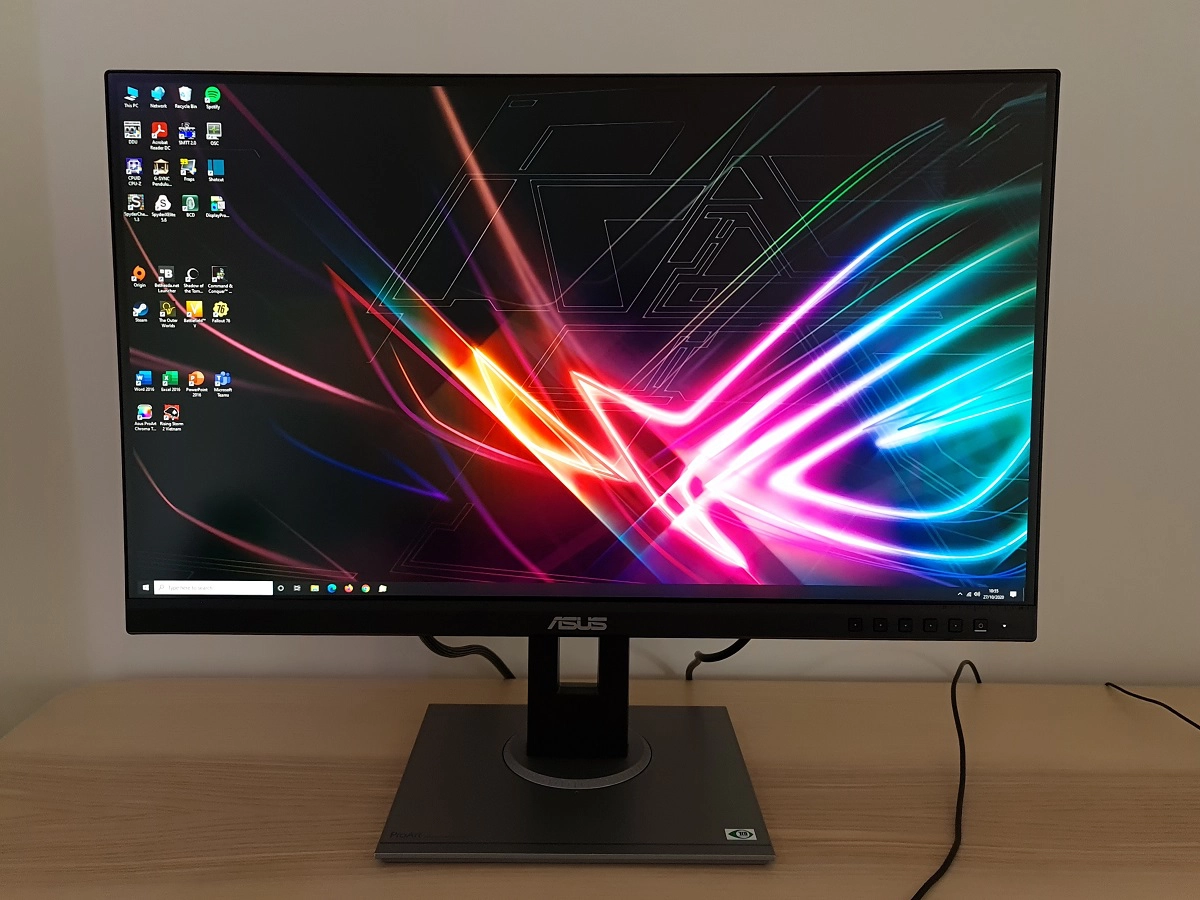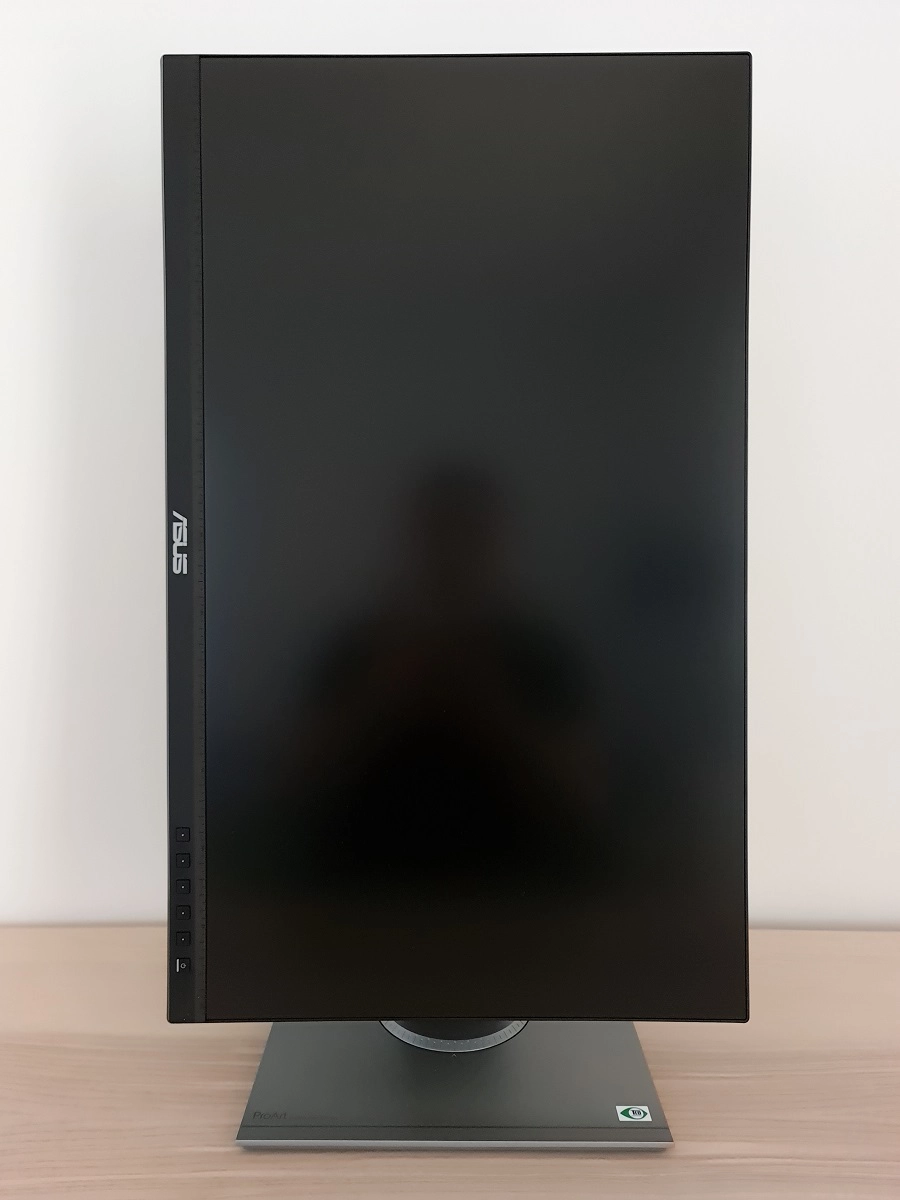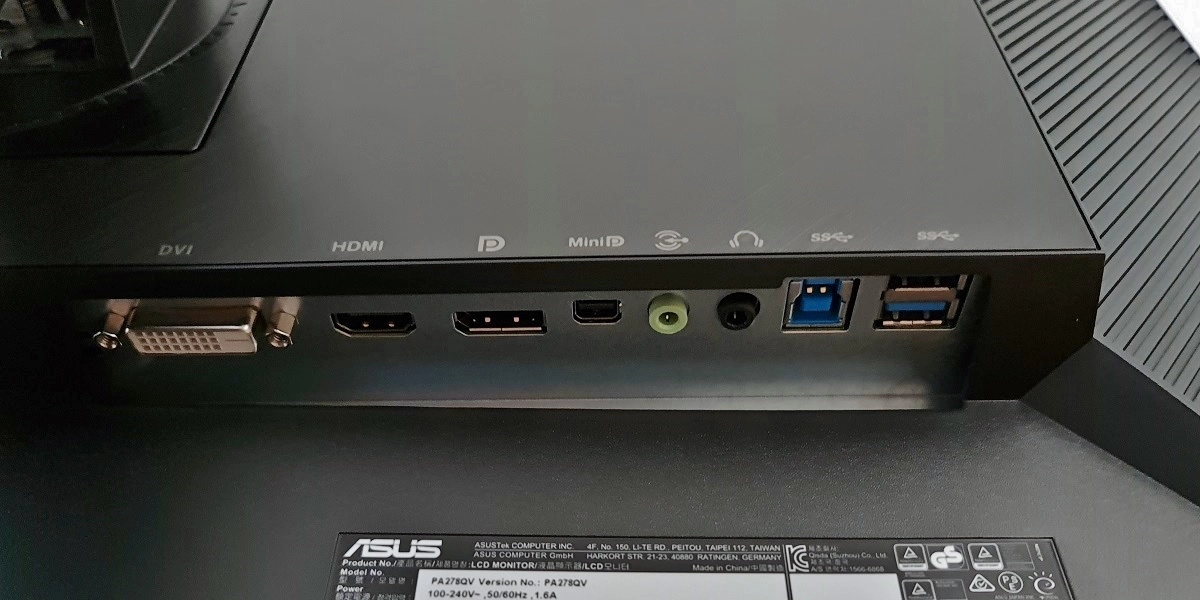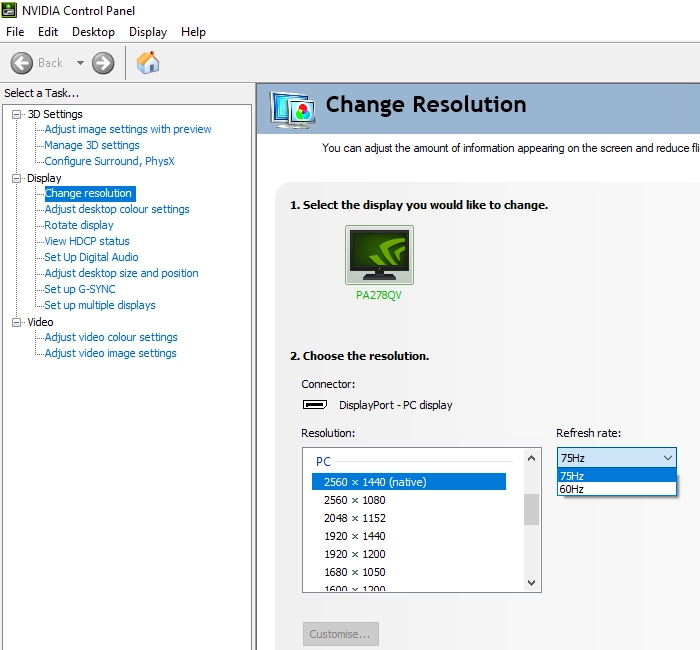Author: Adam Simmons
Date published: November 2nd 2020
Table of Contents
Introduction
For all-round use with a focus on productivity, the 2560 x 1440 (WQHD) resolution can deliver a lot of benefit. The 27” screen size is particularly popular with this resolution in mind, with a range of panel types and refresh rates on offer. The ASUS PA278QV offers an IPS-type panel with a slight bump up in refresh rate from the standard 60Hz to 75Hz. As a member of the ProArt series its main focus is accurate colour output. We put this monitor through our usual testing regime to see how it fares in key areas such as colour reproduction, contrast and responsiveness.
Specifications
The monitor uses a 27” Innolux IPS-type (In-Plane Switching technology) panel with 75Hz refresh rate and support for true 8-bit colour. A 5ms response time is specified, which as usual you shouldn’t pay too much attention to. Some of the key ‘talking points’ for this monitor have been highlighted in blue below.
As an Amazon Associate and Newegg Affiliate I earn from qualifying purchases made using the below link. Where possible, you’ll be redirected to your nearest store. Further information on supporting our work.
|
Features and aesthetics
The monitor offers a smart home-office design with square silver matte plastic stand base and a matte black plastic stand neck and bottom bezel. The bottom bezel is ~25mm (0.98 inches) thick, including a sliver of panel border. There are engraved CM markings (up to 60cm) running along the length of it as a subtle but potentially useful addition. There’s a central painted silver ASUS logo for a bit of contrast. The top and sides bezels are slimmer with a dual-stage design, including a panel border that’s flush with the rest of the screen and a slender hard plastic outer component. They’re ~7.5mm (0.30 inches) thick. The screen has a light matte anti-glare finish, as explored shortly.
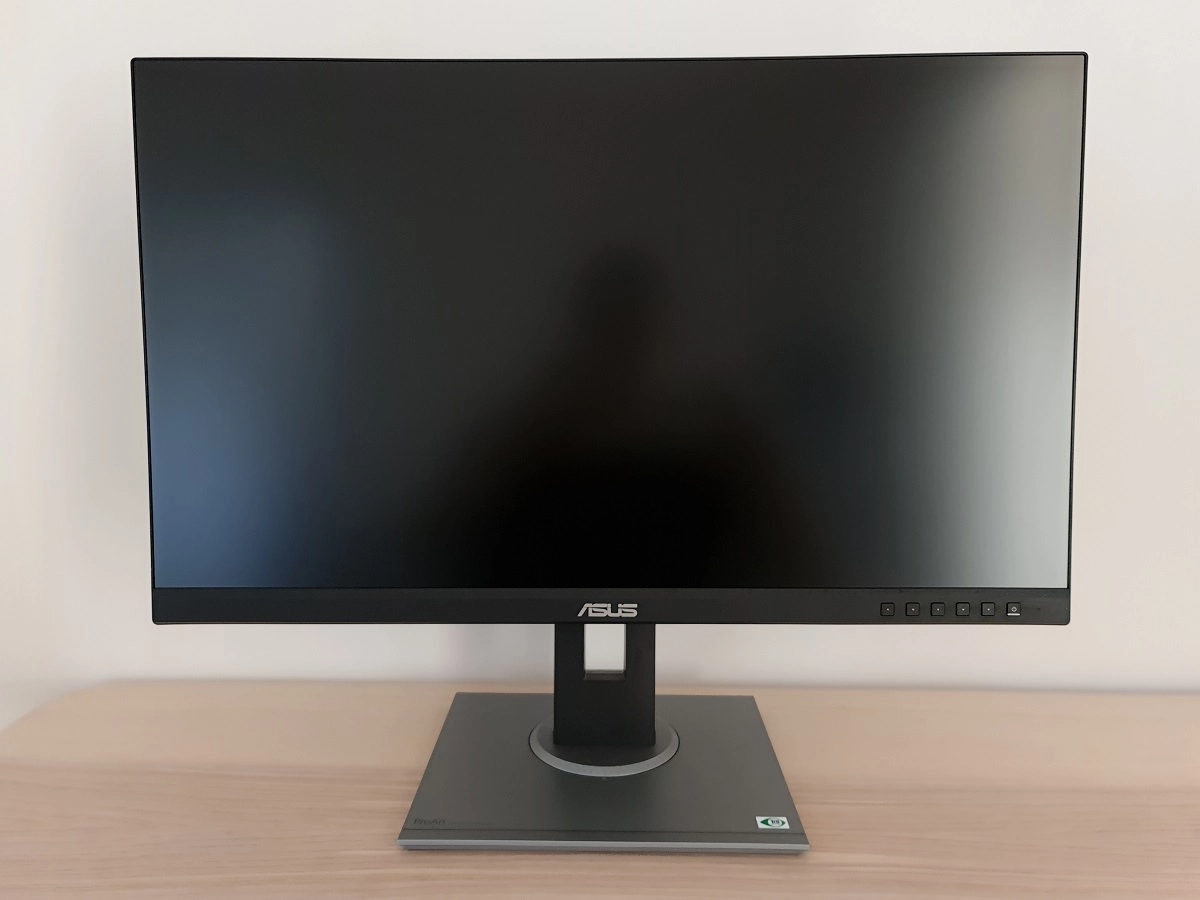

The OSD (On Screen Display) is controlled by pressable buttons, facing forwards towards the right side of the bottom bezel. A very small square power indicator LED is found to the right of these buttons, glowing white when the monitor is on and orange when it enters a low power state. The LED can be disabled in the OSD if preferred. The video below runs through the menu system and ASUS ProArt Chroma Tune software.
From the side the monitor is quite slender – ~17mm (0.67 inches) at thinnest point, bulking out a bit more centrally. There are 2 USB 3.0 ports at the left side. The included stand offers full ergonomic flexibility; tilt (5° forwards, 35° backwards), height (~150mm or 5.91 inches), swivel (90° left, 90° right) and pivot (90° rotation either direction into portrait). At lowest stand height, the bottom of the screen sits ~30mm (1.18 inches) above of the desk surface with the top of the screen ~400mm (15.75 inches) above the desk. The top of the stand neck pokes up an extra 10mm (0.39 inches) or so with the stand in this position. The total depth of the monitor including stand is ~226mm (8.90 inches) with the front of the screen sitting ~35mm (1.38 inches) back from the front edge of the stand. So the design is relatively compact rather than taking up a huge amount of depth on the desk.
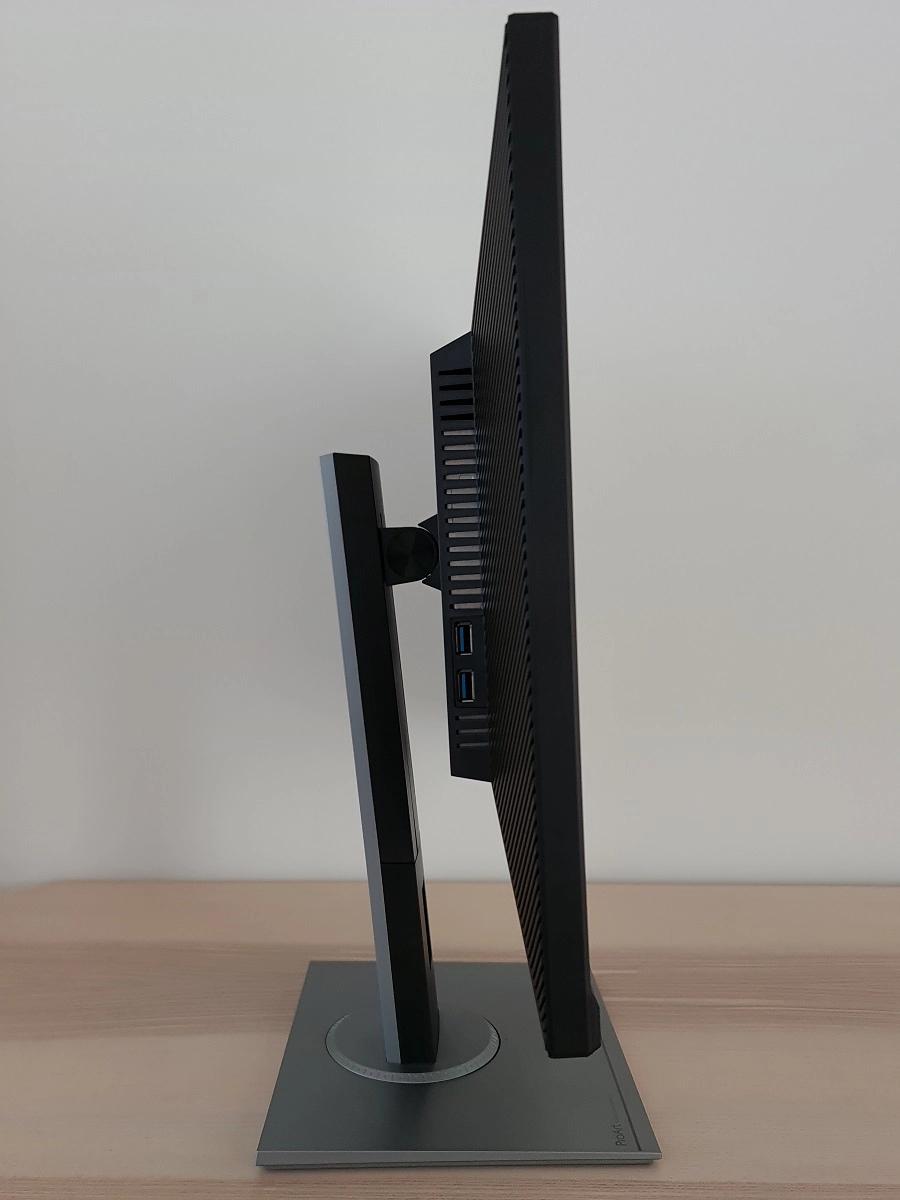
The monitor is matte black plastic of various textures at the rear, aside from the matte silver plastic stand. There is a brushed texture centrally, a corrugated texture towards the side edges and plain matte black plastic elsewhere. Plus a glossy plastic ASUS logo in the top central region, just so it’s visible. The stand attaches centrally using a quick release mechanism, with the release button facing downwards beneath the attachment point. It can be removed to reveal 100 x 100mm VESA holes for alternative mounting. Towards the bottom of the stand neck there’s a gap which acts as a cable tidy system and towards the bottom right of the screen there’s a K-Slot. The ports face downwards and include; AC power input (internal power converter, with ‘zero watt’ power switch), Dual-link DVI, HDMI 1.4, DP 1.2a, MiniDP 1.2a, HDMI 1.4, Dual-link DVI, 3.5mm audio input, 3.5mm headphone jack and 2 USB 3.0 ports (4 total – plus upstream). Note that Mini DisplayPort offers the same capabilities as regular DisplayPort, it’s just a different connector head size. 2 x 2W speakers are included, offering basic and not particularly rich or high-quality sound output.

The native full capabilities of the monitor can be leveraged via DP 1.2a or HDMI 1.4, including 2560 x 1440 @75Hz and Adaptive-Sync. Nvidia’s ‘G-SYNC Compatible Mode’ is supported via DP, whilst AMD FreeSync is supported via DP and HDMI. A power cable is included as standard but additional accessories including an mDP – DP cable, USB cable and 3.5mm audio input vary by region or retailer. The first image below shows the refresh rates supported for the Full HD resolution and the second image the refresh rates supported at the native WQHD resolution. Note that the supported refresh rates are identical for DP and HDMI and that a ‘4k x 2k, 3840 x 2160’ downsampling mode is not included.
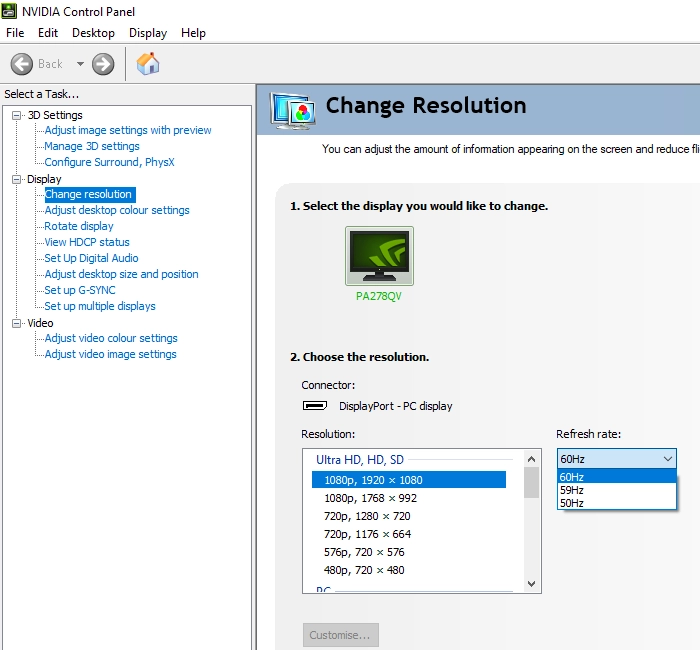
Calibration
Subpixel layout and screen surface
The image below is a macro photograph taken on Notepad with ClearType disabled. The letters ‘PCM’ are typed out to help highlight any potential text rendering issues related to unusual subpixel structure, whilst the white space more clearly shows the actual subpixel layout alongside a rough indication of screen surface. This model uses a light matte anti-glare screen surface, providing respectable glare handling. Additionally, diffusion of light emitted from the monitor is lower than on many matte screen surfaces, better preserving clarity and vibrancy. There isn’t a clearly layered appearance in front of the image, whilst the surface finish is relatively smooth. Brighter content was free from clear graininess and appeared relatively smooth, more so than on most matte screen surfaces.
![]()
As illustrated above the standard RGB (Red, Green and Blue) stripe subpixel layout is used. This is the default expected by modern operating systems such as Microsoft Windows and Apple MacOS. You needn’t worry about text fringing from non-standard subpixel layouts as a Mac user and don’t need to run ClearType as a Windows user. You may still wish to run through the ClearType wizard and adjust according to preferences, however. The subpixel layout and arrangement is normal and we had no subpixel-related concerns related to sharpness or text clarity on this model.
Testing the presets
The ASUS PA278QV features a range of ‘ProArt Preset’ modes; ‘Standard’, ‘sRGB’, ‘Rec. 709’, ‘Scenery’, ‘Reading’, ‘Darkroom’, ‘Rapid Rendering’, ‘User Mode 1’ and ‘User Mode 2’. In general these presets just set things in the OSD to various values and in some cases lock off various controls. A notable exception is ‘Rapid Rendering’, a strobe backlight setting explored later. We briefly ran through these presets in the OSD video earlier. For the purposes of this table we’ll only focus on a few of these, plus manual adjustments that can be made in the OSD. The table below includes gamma and white point readings taken using a Datacolor SpyderX Elite colorimeter alongside general observations made by eye. Our test system runs Windows 10, with an Nvidia GTX 1080 Ti connected using a DP cable. Additional testing was performed via HDMI and also using an AMD Radeon RX 580, but the observations on this table didn’t differ significantly between inputs or GPUs. The monitor was left to run for over 2 hours prior to readings being taken and observations made, without any additional monitor drivers or ICC profiles specifically loaded. Aside from our ‘Test Settings’, where various adjustments were made, assume factory defaults were used. The refresh rate was set to 75Hz in Windows, although this didn’t significantly affect the values or observations in this table. When viewing the figures in this table, note that for most PC users ‘6500K’ for white point and ‘2.2’ for gamma are good targets to aim for. Individual targets depend on individual uses, tastes and the lighting environment, however.
| Monitor Settings | Gamma (central average) | White point (kelvins) | Notes |
| Standard Mode, Gamma = 2.2 (Factory Defaults) | 2.2 | 6273K | A rich and natural look throughout the screen, well balanced overall. |
| Gamma = 1.8 | 1.8 | 6802K | As above but much less depth (quite washed out looking) due to low gamma. |
| Gamma = 2.0 | 2.0 | 6285K | Gamma slightly higher but still a lack of depth compared to factory defaults. May set colour temperature to ‘5000K’ when first activated – can be corrected to ‘6500K’ and will be remembered in future. |
| Gamma = 2.4 | 2.4 | 6276K | Increased gamma over factory defaults, giving extra depth. |
| Gamma = 2.6 | 2.6 | 6263K | As above with further increase in gamma. Quite a cinematic look with too much depth in places (loss of detail). |
| sRGB Mode | 2.2 | 6115K | Relatively dim with many settings (including brightness) locked off. Warm tint remains and can’t be adjusted. Colour gamut slightly different to native but still extends a bit beyond sRGB in some regions (this isn’t extreme even natively) – so just an annoyingly restrictive setting rather than a true sRGB emulation mode. |
| Blue Light Filter = Level 1 | 2.2 | 5491K | A weak Low Blue Light (LBL) setting. This offers a slight reduction in blue light output by reducing blue colour channel strength. The image appears warmer than factory defaults with a green tint due to relatively strong green channel. |
| Blue Light Filter = Level 2 | 2.2 | 5385K | A very slightly stronger LBL setting. A further reduction in blue light output and warmer look to the image. |
| Blue Light Filter = Level 3 | 2.2 | 5242K | As above, very slightly stronger effect again. |
| Low Blue Light = Level 4 | 2.2 | 4753K | A very effective LBL setting. Brightness reduced and control locked off. Image appears warm with a green tint (eyes adjust to some extent over time). |
| Color Temp. = 5000K | 2.2 | 4699K | An alternative LBL setting. Highly effective but better balanced visually due to green channel reduction removing green tint. Brightness control also available. |
| Test Settings | 2.2 | 6502K | A rich, natural and well-balanced image with good variety and consistency. |
The monitor provided pleasing balance straight from the box – aside from brightness being too high for our liking, which is a common complaint and easy to rectify in the OSD. Each unit includes its own individual ‘Calman Verified’ factory calibration report. For the best performance on your own unit and system and as things shift over time, it’s best to calibrate and periodically recalibrate using your own colorimeter or similar device. But a solid factory performance as shown here and confirmed by our own testing is always reassuring to see.
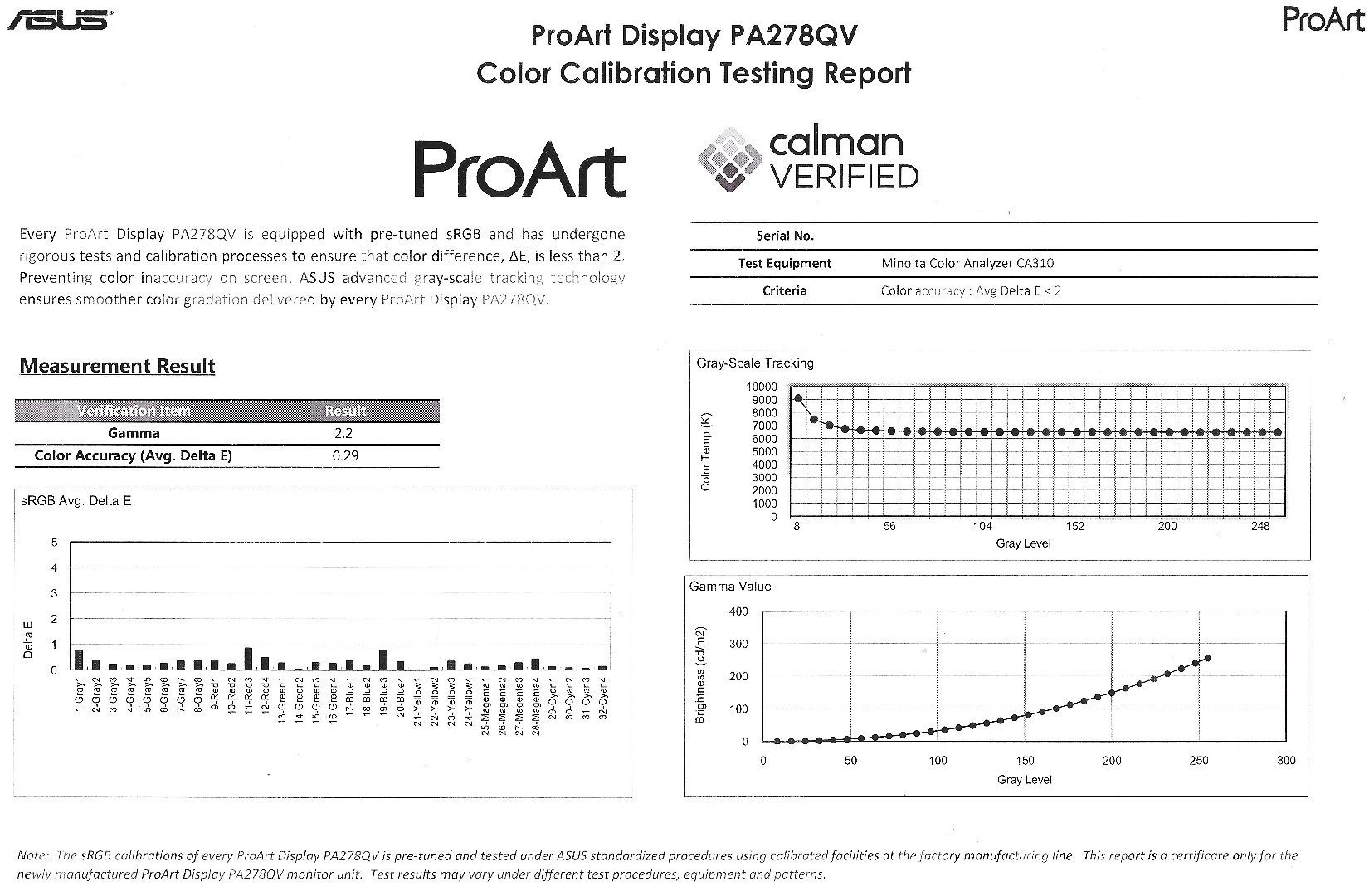
We had to make minor adjustments to the colour channels to get the white point where we wanted it, but gamma tracked very close to the desired ‘2.2’ curve and the overall balance to the image for sRGB content was pleasing. As we explore later, the monitor good sRGB coverage and is standard gamut. It avoids the pitfalls of an untamed wide gamut, the common inflexibilities of an sRGB emulation mode or poor performance from significant sRGB undercoverage. All of which would be detrimental to accuracy within the sRGB colour space. The graph below shows the gamma curve under our ‘Test Settings’, sitting tight to the desired ‘2.2’ curve.
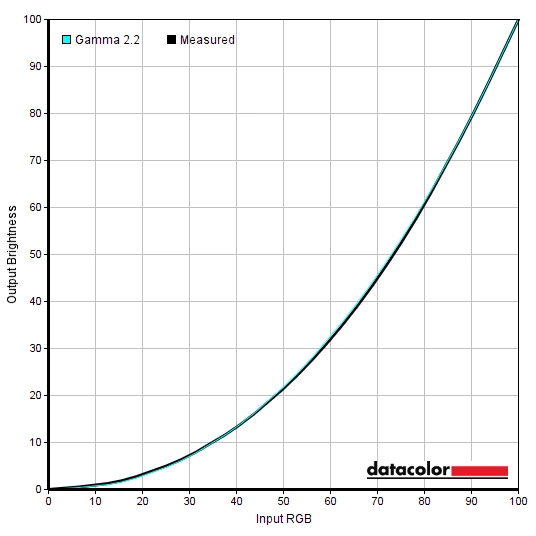
Gamma 'Test Settings'
Due to inter-unit variation and excellent performance following OSD tweaking alone we will not be using any ICC profiles for this review or including any measurements or graphs using them. We wouldn’t recommend using them unless created for your specific unit using your own calibration device. But we appreciate some users still like to use profiles and some aspects such as gamut mapping for colour-aware applications can be useful. You can download our ICC profile for this model, which was created using our ‘Test Settings’ as a base. Note again that these ICC profiles are not used in the review.
The monitor offers a range of Low Blue Light (LBL) settings, with the main one the aptly named ‘Low Blue Light’ setting. This can be set to 4 levels; ‘Level 1’, ‘Level 2’, ‘Level 3’ and ‘Level 4’ – with a higher level giving a stronger effect. Whilst we found ‘Level 4’ particularly effective, it also locked off the brightness control. These settings also impart a green tint to the image as a relatively strong green channel is maintained. Reducing the green channel often has a negative impact on contrast which is why things are done this way. Reducing blue light exposure is particularly important in the hours leading up to sleep as blue light is stimulating to the body and affects sleep hormones. It increases alertness and makes it more difficult to ‘shut off’. We preferred setting ‘Color Temp.’ to ‘5000K’ as it is still highly effective but better balanced with a reduced green channel and unlocked brightness control. We used this setting on top of our ‘Test Settings’ for our own viewing comfort in the evenings. It wasn’t active for any particular testing of the monitor except where the setting is explicitly mentioned.
Test Settings
The monitor provided a good balance out of the box. The main thing we needed to do was reduce the brightness, but also make minor adjustments to the colour channels. It’s important to remember that individual preferences vary and that different units of the same model will require different adjustments. These settings are simply a suggestion and won’t be optimal in all cases. Assume that any setting not mentioned here was left at default in the OSD, including ‘Contrast’ and ‘Gamma’. We’ve also included our preferred ‘Trace Free’ setting, Adaptive-Sync status and the refresh rate used for most of the review, just for reference.
ProArt Preset= User Mode 1 (‘Standard’ and ‘User Mode 2’ could be used as a base instead)
Brightness= 19 (according to preferences and lighting)
Color – R Gain= 46
Color – G Gain= 50
Color – B Gain= 50
Trace Free= 60
Adaptive-Sync= On
Contrast and brightness
Contrast ratios
We used an X-Rite i1Display Pro to measure white and black luminance levels, from which static contrast ratios could be calculated. The table below shows this data, with various settings used. Assume any setting not mentioned was left at default, except for the changes already noted in the calibration section. Black highlights indicate the highest white luminance, lowest black luminance and maximum contrast ratio recorded under SDR. Blue highlights indicate the results under our ‘Test Settings’.
| Monitor Settings | White luminance (cd/m²) | Black luminance (cd/m²) | Contrast ratio (x:1) |
| 100% brightness | 431 | 0.43 | 1002 |
| 80% brightness | 401 | 0.40 | 1003 |
| 60% brightness | 372 | 0.37 | 1005 |
| 40% brightness | 297 | 0.30 | 990 |
| 20% brightness | 178 | 0.18 | 989 |
| 0% brightness | 57 | 0.06 | 950 |
| 50% brightness (Factory Defaults) | 356 | 0.35 | 1017 |
| Gamma = 1.8 | 356 | 0.35 | 1017 |
| Gamma = 2.0 | 356 | 0.35 | 1017 |
| Gamma = 2.4 | 355 | 0.35 | 1014 |
| Gamma = 2.6 | 355 | 0.35 | 1014 |
| sRGB Mode | 114 | 0.11 | 1036 |
| Low Blue Light= Level 1 | 356 | 0.35 | 1017 |
| Low Blue Light= Level 2 | 355 | 0.35 | 1014 |
| Low Blue Light= Level 3 | 354 | 0.35 | 1011 |
| Low Blue Light= Level 4 | 175 | 0.18 | 972 |
| Color Temperature = 5000K | 302 | 0.36 | 839 |
| Rapid Rendering Mode = Normal | 71 | 0.07 | 1014 |
| Rapid Rendering Mode = Advanced | 34 | 0.04 | 850 |
| Test Settings | 164 | 0.17 | 965 |
The average contrast ratio with only brightness adjusted was 990:1, very close to the 1000:1 specified for the panel. The maximum contrast recorded was 1036:1, whilst we recorded 965:1 under our ‘Test Settings’. Which is decent enough for the panel type, with only a slight drop due to the adjustments made. The ‘Low Blue Light’ settings had little effect on contrast as they maintained a strong green channel. ‘Color Temperature = 5000K’ on the other hand lowers the green channel at the expense of contrast – we measured 839:1 using this setting. The highest luminance recorded was 431 cd/m², comfortably exceeding the 350 cd/m² specified for the panel. The minimum white luminance recorded (Rapid Rendering disabled) was 57 cd/m², reasonably low but not exceptionally low. This gave a luminance adjustment range of 375 cd/m².
The monitor offers a Dynamic Contrast setting called ASCR (ASUS Smart Contrast Ratio) that can be activated in the ‘Scenery’ or (ironically) ‘Dark Scene’ modes. Both offer strong digital oversaturation, carried over when using ASCR and can be counteracted by reducing the ‘Saturation’ slider. The ASCR setting blocks off the brightness control and adjusts the backlight brightness according to the level of light or dark in a scene. As usual the backlight is controlled as a single unit. We found the monitor very bright unless the scene was almost entirely composed of dark shades when using this setting. It was brightest when predominantly bright content was displayed. As usual we prefer manual control over brightness.
PWM (Pulse Width Modulation)
The PA278QV uses PWM (Pulse Width Modulation) with a cycling frequency of ~20kHz to reduce backlight brightness. This is a very high frequency, sufficient to be considered ‘flicker free’ under the TÜV Rheinland certification system. No PWM artifacts were observed during motion and we didn’t experience accelerated eye fatigue compared to using a screen with DC dimming. Everybody’s eyes are different and we appreciate some users would prefer the reassurance of DC dimming for backlight regulation. Most users shouldn’t worry about PWM at such a high frequency, even if they’ve found models with more usual PWM frequencies (e.g. 480Hz or below) bothersome. There are many factors to consider when it comes to viewing comfort on a monitor beyond PWM usage.
Luminance uniformity
Whilst observing a black background in a dark room, using our ‘Test Settings’, we noticed some backlight bleed and clouding. It’s important to note that individual units vary when it comes to backlight bleed and clouding. The image below shows the results on our units, taken a sufficient distance back to eliminate ‘IPS glow’. This is most noticeable towards the bottom corners of the screen, from a normal viewing position. It appears as a bluish silver haze towards the bottom left and a a warm and slightly green golden haze towards the bottom right. It can also be observed further up the screen depending on viewing position. It ‘blooms out’ from sharper viewing angles with hue depending on the angle, as demonstrated in the viewing angles video later on.
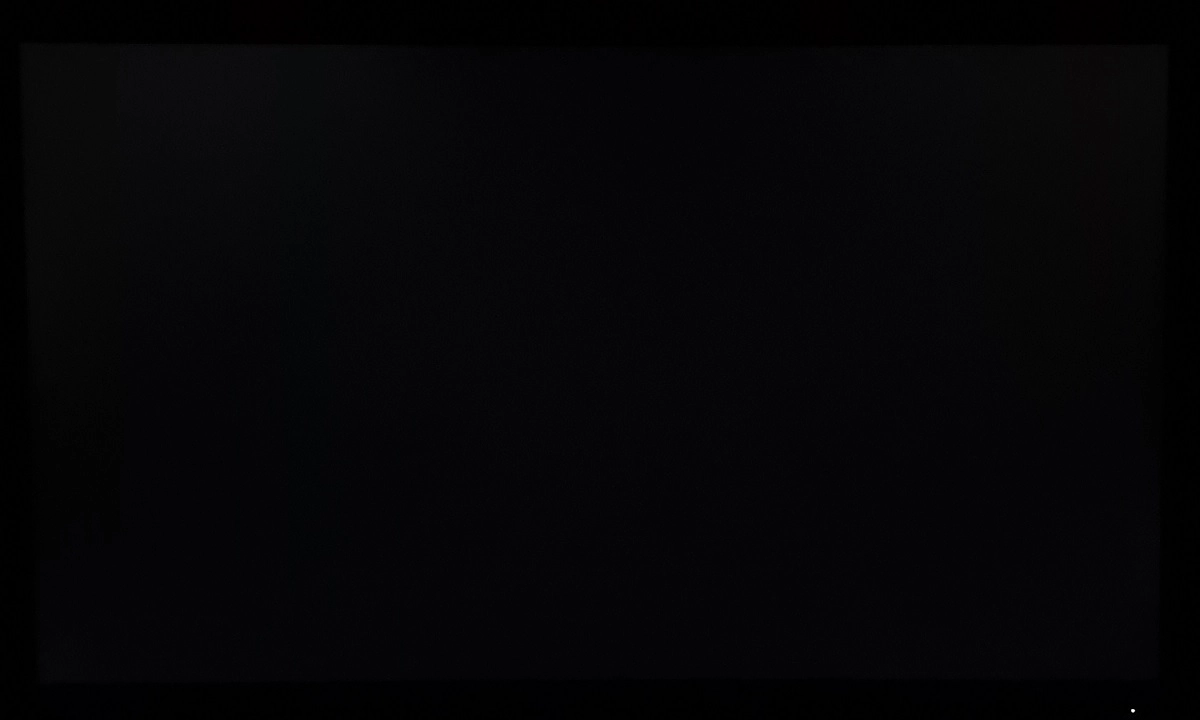
The SpyderX Elite was used to assess the uniformity of lighter shades, represented by 9 equidistant white quadrants. The luminance of each quadrant was measured and compared to the brightest measured quadrant. The table below shows these values as well as the percentage deviation between each quadrant and the brightest point measured.

Luminance uniformity table
The luminance uniformity was good. The brightest point recorded was ‘quadrant 5’ in the centre of the screen (164.1 cd/m²). The greatest deviation from this occurred at ‘quadrant 8’, below the central region (146.9 cd/m², which is 10% dimmer). The average deviation between each quadrant and the brightest point was 7.25%, which is good. It’s important to remember that uniformity varies between individual units and you can also expect variation beyond the points measured. The contour maps below show these deviations graphically, with darker greys representing lower luminance and hence greater deviation from the brightest recorded point than lighter greys. Percentage deviations between each quadrant and the brightest point are also given.
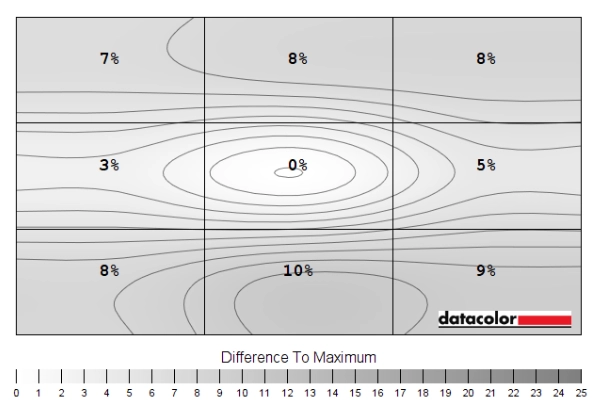
Luminance uniformity map
The SpyderX Elite was also used to analyse variation in the colour temperature (white point) for the same 9 quadrants. The deviation between each quadrant and the quadrant closest to the 6500K (D65) daylight white point target was analysed and a DeltaE value assigned. A DeltaE >3 represents significant deviation that most users could readily notice by eye.
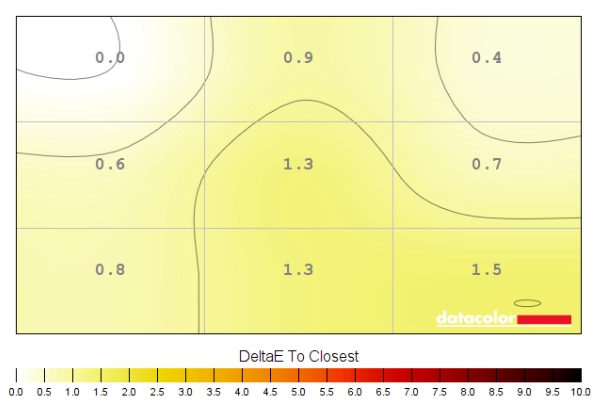
Colour temperature uniformity map
The colour temperature uniformity was strong, without any significant deviations recorded. The maximum deviation recorded was DeltaE 1.5 towards the bottom right, which is pleasing. It’s again important to remember that individual units vary when it comes to uniformity and that deviation beyond the measured points should be expected.
Contrast in games and movies
On Battlefield V the monitor provided a reasonable contrast experience. You don’t get an excellent atmosphere in dark scenes or deep and inky looking dark shades here, especially in dimmer lighting. But things are in-line with expectation for the panel type, where contrast is not a key strength. There’s still a slight edge over some IPS-type panels due to some models offering closer to 700:1 – 800:1 static contrast, but nothing earth shattering. There was a moderate amount of ‘IPS glow’ which ate away at some of the atmosphere, particularly towards the bottom corners of the screen from a normal viewing position. This ‘sheen’ and lightening up of darker content was at a typical level for an IPS-type panel. It was brought out a bit more on our unit towards the top left due to some clouding in that region on our screen, but this sort of thing is not unusual to see. Gamma consistency was excellent, so detail levels for dark content were appropriate throughout the screen. You didn’t get a detail gradient as you’d see vertically on TN models or the masking of detail centrally vs. excessive detail peripherally associated with VA models. The excessive detail on VA and moreover TN models can cause a banded or ‘blocky’ appearance, so it’s nice to avoid that. Brighter content stood out reasonably well against darker surroundings, whilst the screen surface kept things looking relatively smooth there without obvious graininess or clear layering in front of the image.
Shadow of the Tomb Raider is a title with plenty of dimly lit caves, passageways and the like so looks its best on a monitor with strong contrast. This monitor again provided a reasonable contrast experience, but didn’t give your typical scene on this title a deep or atmospheric appearance. ‘IPS glow’ was again observed, with a silverish blue or slightly warm tint depending on angle. This isn’t readily observed in a brighter room, but is clear in dimmer lighting. Turning up the monitor brightness, sitting closer to the monitor or having a unit with strong backlight bleed or clouding can bring this out more strongly. Brighter content such as flames lighting up dim passageways or the bright daylight sky appeared relatively smooth without clear graininess. The gamma consistency was again clear, without excessive detail or indeed heavy masking of detail depending on where on the screen you’re observing. The porous texture of rocks that are a cue in this game that a wall can be climbed, for example, were always visible. In contrast to a TN model where they’d be as good as invisible near the top of the screen and far too clear lower down.
We also observed the film Star Wars: The Rise of Skywalker. There are plenty of high-contrast scenes in this title as well, with bright pulses of energy and other light sources illuminating much darker surroundings. The film didn’t have the cinematic look that some models provide, especially in ambient lighting. But we’ve seen worse from IPS-type panels as well, with some offering slightly weaker static contrast. The strong gamma consistency and relatively smooth appearance to the screen surface was again observed, and on the flip-side so was ‘IPS glow’. The strong gamma consistency is particularly important when considering heavily compressed streamed content, such as YouTube videos or some content on platforms such as Netflix. This content contains ‘compression artifacts’ which can be brought out in an obvious way due to lower than ideal perceived gamma. This is especially obvious lower down on TN models – here, though, they were appropriately masked.
Lagom contrast tests
The Lagom tests for contrast allow specific weaknesses in contrast performance to be identified. The following observations were made.
- The contrast gradients were displayed well overall, with most blocks showing distinct brightness steps. The darkest blue and reds block blended into the background a little too readily.
- Performance on the black level test was good. The first few blocks blended into the background quite readily, which is usual if a monitor tracks the ‘2.2’ gamma curve correctly. There was no obvious dithering.
- Performance on the white saturation test was very good, with all but the final block distinct from the background. The often-illusive final block was only very faintly visible.
- The greyscale gradient appeared smooth without clear banding or dithering.
Colour reproduction
Colour gamut
The ASUS PA278QV’s colour gamut (red triangle) was compared with the sRGB reference colour space (green triangle). The first image shows the results using our ‘Test Settings’, reflecting the native gamut of the monitor. The second image shows the results using the ‘sRGB’ preset. Under our ‘Test Settings’ we recorded comprehensive sRGB coverage (99%) with a bit of extension beyond. Although not shown in the graphic, we measured 81% DCI-P3 and 76% Adobe RGB coverage. This slight extension in the gamut beyond sRGB invites just a little extra vibrancy and saturation, whilst keeping shades quite faithful to the original developer intentions. The ‘sRGB’ mode was not a true emulation setting as all it really did was slightly cut the gamut down in the green to red region, where the extension was already very slight. Whilst the somewhat greater overextension in the red to blue region remained. We measured 98% sRGB coverage with this setting. For most users the native gamut of the monitor will provide good results and the restrictive sRGB setting with locked colour channels and brightness is best avoided. To maximise colour accuracy within the sRGB colour space, for colour-managed workflows, full calibration and profiling with a colorimeter or similar device is always optimal.
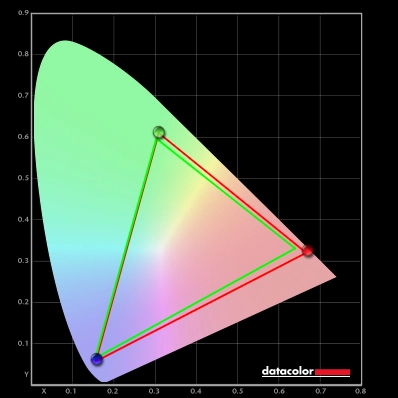
Colour gamut 'Test Settings'
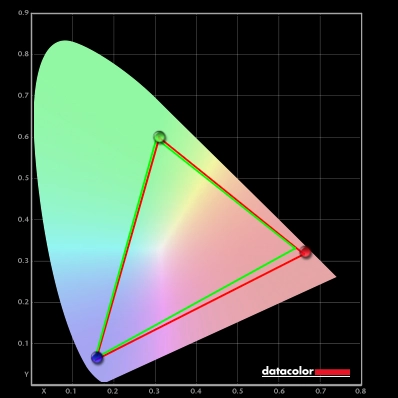
Colour gamut 'sRGB'
AMD GPU users can activate a flexible sRGB emulation setting via the graphics driver. This is done by opening ‘AMD Radeon Software’, clicking ‘Settings’ (cog icon towards top right) and clicking on ‘Display’. You should then ensure that the ‘Custom Color’ slider to the right is set to ‘Enabled’ and ‘Color Temperature Control’ set to ‘Disabled’. This is shown in the image below.

The gamut below shows results using our ‘Test Settings’ with this driver tweak applied. The colour gamut now offers strong sRGB coverage (99%) with less extension beyond compared to natively. This is a useful setting if you’re an AMD user and wish to gain closer tracking of the sRGB gamut without profiling, including in applications that aren’t colour-managed.
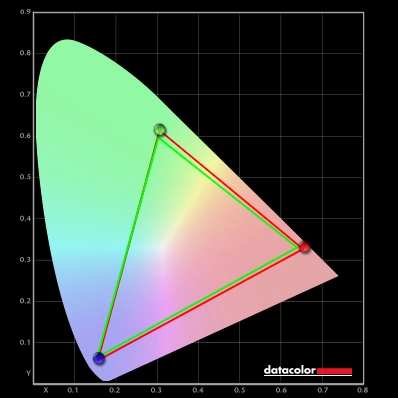
Colour gamut AMD 'CTC disabled' setting
Colour in games and movies
On Battlefield V the monitor presented shades in a rich and natural way, with good variety. The colour gamut reaches just a little beyond sRGB, inviting just a touch of extra vibrancy and saturation. But this was a slight uplift compared to monitors with a wider gamut when observing content like this, designed with the sRGB colour space in mind. When combined with the strong factory calibration (plus minor tweaks under our ‘Test Settings’), it gave a look that’s really quite faithful to the developer’s original intentions. Environments showcased a good range of subtly different neutral earthy tones, with just a small red push from the gamut rather than a clear loss of neutrality. There were some fairly lush-looking greens – not as deep or vibrant as on models with a wider gamut – alongside a nice palette of more muted pastel shades. There wasn’t a clear yellow push to yellowish green shades as we sometimes see, either. There were some decent licks of vibrancy in places, for example flames which appeared slightly richer than they would strictly under the sRGB colour space. But they didn’t look too lively – on some models yellows start verging on orange and oranges on red, whereas here the shade identity was more appropriate.
Shadow of the Tomb Raider showcased a similar range of rich and natural shades. Skin tones such as that of the main character Lara Croft can sometimes look overly tanned or at times slightly sunburnt depending on the gamut. In this case her skin looked much as it should. The strong colour consistency also meant that the richness and saturation was maintained throughout the screen. In contrast to VA or IPS technology where some saturation is lost and shades can appear duller in some regions of the screen. Environments again drove home the ‘rich and natural’ appearance. The uplift in saturation here was again slight, so didn’t affect the neutrality or shade identity in the same way as a wide gamut model. But was enough to give just a little hint of extra vibrancy.
We also observed various episodes of the TV series Futurama. With large areas of individual shade on the screen, this is a particularly unforgiving test for colour consistency. The monitor provided a strong performance here, with a nice variety of shades displayed with appropriate identity. Deep and neon shades such as deep purple and neon green were displayed in a reasonably vivid way. Not to the extent observed on a wide gamut model, but they appeared appropriately eye-catching compared to more muted shades. These more muted or pastel shades were shown with excellent variety, with even subtle variations such as slightly different character skin tones observable. This was aided by the strong consistency, with appropriate richness throughout the screen. These pastel shades would appear more lively than intended on wider gamut models, whilst VA and moreover TN models will show them in a much less saturated way in some regions of the screen.
Shade representation using SpyderCHECKR 24
The image below shows a printed reference sheet of 24 ‘sRGB’ shades, included as part of the Datacolor SpyderCHECKR 24 package. The screen is displaying reference photographs of this printed sheet, in both the same order as printed (right side) and reverse order (left side). The camera is mounted slightly above centre so that the image is representative of what the eye sees from an ergonomically correct viewing position. This, coupled with the inclusion of a flipped version of the shade sheet, allows both accuracy and colour consistency to be visually assessed. Bracketed numbers in our analysis refer to shades on the printed sheet or right side of the screen if they’re ordered consecutively from top left to bottom right. Interlaced lines visible in some places on the image are moiré from the camera, not observed on the monitor itself.
Note that there is always some disparity between how emissive objects (monitor) and non-emissive objects (printed sheet) appear. The representation of shades in this image depends on the camera and your own screen, it’s not designed to show exactly how the shades appear in person. It still helps demonstrate some of the relative differences between the original intended sRGB shade and what the monitor outputs, however. Full profiling and appropriate colour management on the application would provide a tighter match, our intention here is to show what can be expected in a non colour-managed environment.
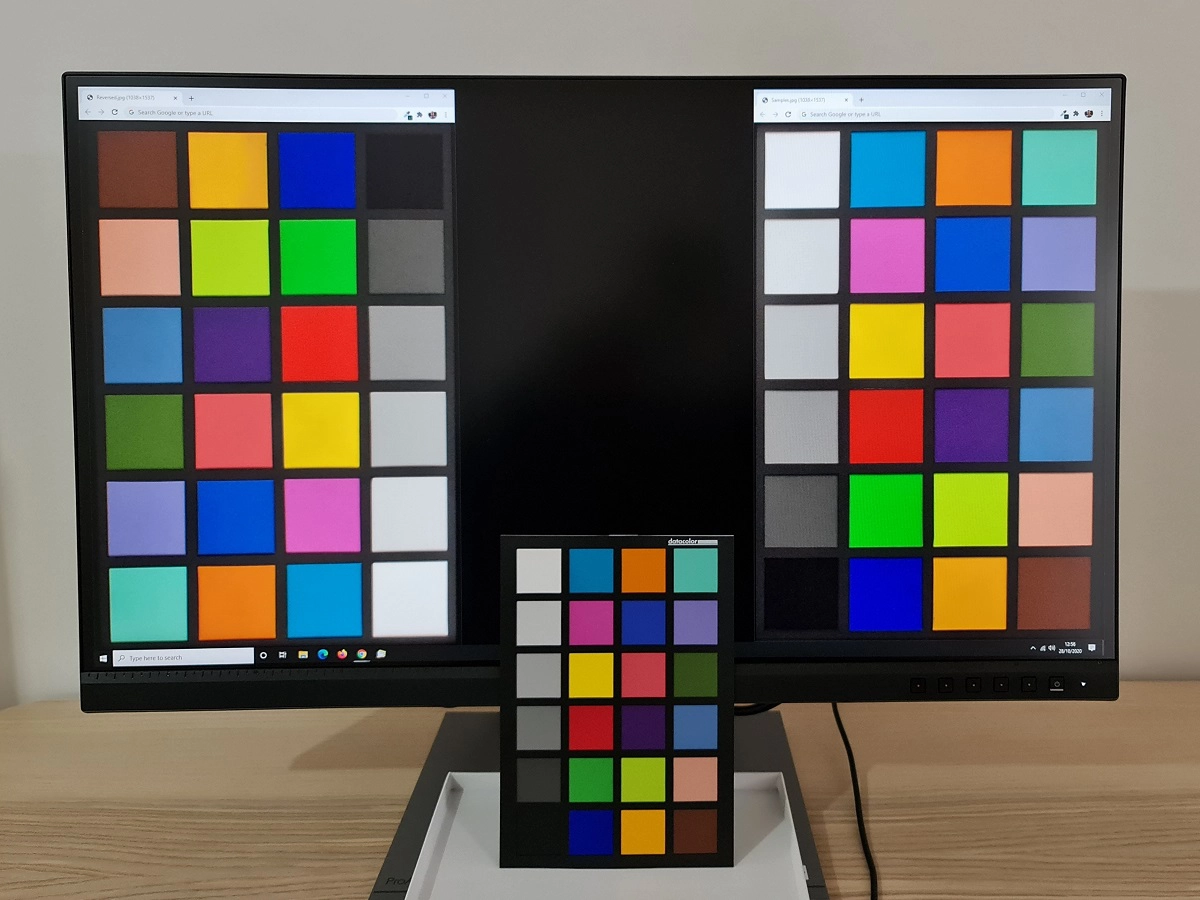
The monitor offers faithful reproduction of these shades with deviations that are much more minor than you’d see on models with a wider colour gamut. And indeed on a model with poorer ‘post OSD tweaking’ calibration. Whilst some shades such as dark brown appear just a touch undersaturated on the monitor, in this image, this is due to how it was captured and not observed in person. It’s difficult to illuminate the printed sheet appropriately without causing a small amount of glare on some sections of the monitor. The consistency of shades is also excellent, with the representation of a given shade similar on the left (reverse order) and right side (printed order) of the screen. We were pleased to see appropriate representation of medium orange (3), aquamarine (4) and gamboge (23) as these often appear either undersaturated or oversaturated. Dark lime green (18) with candy apple red (14) appearing just a touch livelier than it should. This is due to the slight extension beyond sRGB in the colour gamut – a subtle difference compared to the neon appearance such shades take on with untamed wide gamut models, however. Profiling the monitor with your own colorimeter or spectrophotometer is always advised for best results if the strongest colour accuracy is desired, but the monitor performs well even without such a level of correction.
Viewing angles
Lagom’s viewing angle tests help explore the idea of colour consistency and viewing angle performance. The following observations were made from a normal viewing position, eyes ~70cm from the screen.
- The purple block appeared a slightly pinkish purple throughout the screen. The pink hue was slightly stronger at the very edges of the screen. Much more consistent than VA or TN models where the pink hue is stronger and shifts alongside head movement.
- The red block appeared a rich and consistent read throughout the screen. There was no clear pink hue that would be observed and would shift with head movement on VA or TN models.
- The green block appeared a (slightly yellowish) green chartreuse throughout. It was free from a clear strengthening yellow tint at some regions of the screen as you’d observe on models with weaker colour consistency.
- The blue block appeared royal blue throughout the screen.
- The Lagom text appeared a blended grey throughout, with a very slight green striping to the text. Further down the screen there was a very slight red striping. The monitor was free from saturated red, orange or green tints that shift readily with head movement. This indicates a low viewing angle dependency to the gamma curve of the monitor, typical for an IPS panel.
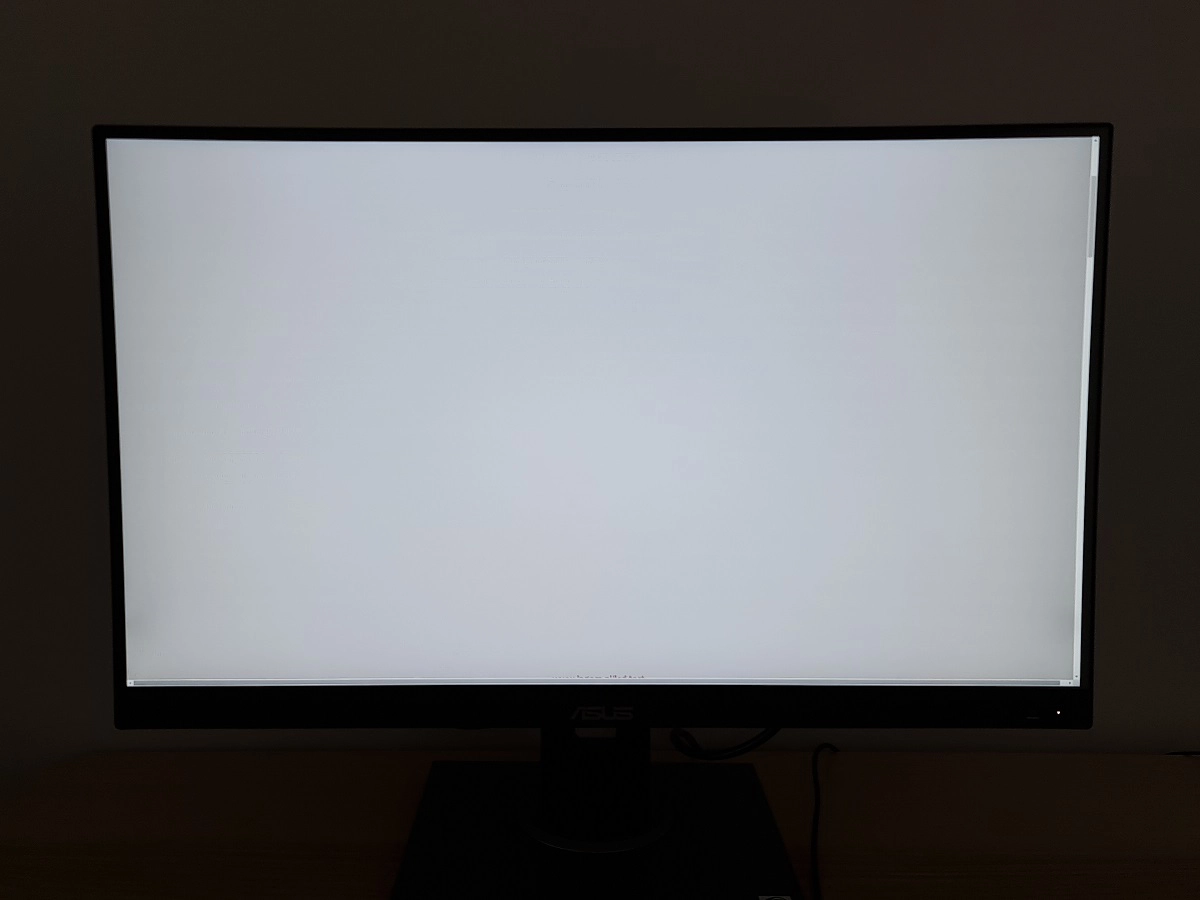
The video below shows the Lagom text test, a mixed desktop background, game scene and dark desktop background from a variety of viewing angles. You can see relatively minor shifts in contrast and colour for the mixed desktop background and game scene. Less pronounced than you’d see on TN or VA models. The dark desktop background highlights ‘IPS glow’, a haze which becomes increasingly strong as viewing angles become steeper. Depending on angle, the glow may take on a cool bluish-silver appearance or warm and slightly greenish golden hue.
Interlace pattern artifacts
On some monitors, particularly but not exclusively those with high refresh rates, interlace patterns can be seen during certain transitions. We refer to these as ‘interlace pattern artifacts’ but some users refer to them as ‘inversion artifacts’ and others as ‘scan lines’. They may appear as an interference pattern, mesh or interlaced lines which break up a given shade into a darker and lighter version of what is intended. They often catch the eye due to their dynamic nature, on models where they manifest themselves in this way. Alternatively, static interlace patterns may be seen with some shades appearing as faint horizontal or vertical bands of a slightly lighter and slightly darker version of the intended shade. We did not observe either artifact type on this monitor.
Responsiveness
Input lag
A small utility called SMTT 2.0 was used alongside a sensitive camera to analyse the latency of the PA278QV, with over 30 repeat readings taken to help maximise accuracy. Using this method, we calculated 5.12ms (under ½ a frame at 75Hz) of input lag. At 60Hz we measured a marginally higher but still reasonable 6.73ms. The input lag measured here reflects both the element you ‘see’ (pixel responsiveness) and the element you ‘feel’ (signal delay). It indicates a fairly low signal delay which most users should be just fine with. Note that we don’t have the means to accurately measure input lag with Adaptive-Sync active in a variable refresh rate environment.
Perceived blur (pursuit photography)
Our article on responsiveness explores the key aspects of monitor responsiveness. Chief amongst these is the concept of ‘perceived blur’, which is contributed to by both the movement of your eyes as you track motion on the screen and the pixel responses of the monitor. The first element dominates on a modern monitor, but pixel responses also play a key role. The responsiveness article also covers a photography technique referred to as ‘pursuit photography’. This uses a moving rather than stationary camera to capture motion in a way that reflects both elements of perceived blur. This contrasts with the use of a stationary camera, capturing motion in a way that only reflects pixel responsiveness.
The images below are pursuit photographs taken using the UFO Motion Test for ghosting, with the test running at 960 pixels per second. This is a good practical speed for capturing such photographs and highlights both elements of perceived blur nicely. The UFOs move across the screen from left to right at a frame rate matching the refresh rate of the display. The monitor was tested at 60Hz (directly below) and 75Hz using various ‘Trace Free’ (TF) settings: ‘40’, ‘60’, ‘80’ and ‘100’. ‘0’ and ‘20’ were excluded from this analysis as the monitor just shows a gentle ramp up in pixel overdrive from ‘0’ to ‘40’. Even a TF setting of ‘40’ offers fairly gentle acceleration and there’s no real reason to use anything lower. All background shade levels (dark, medium and light) were used to highlight a range of pixel transitions between different shades. The final column shows reference displays, where possible, set to what we consider their optimal pixel overdrive setting for the refresh rate. The first reference screen is the ViewSonic XG270QC, a 27” VA offering. The second reference is the ViewSonic XG270QG, a responsive IPS model.
Note that wavy patterns surrounding some UFOs in the background are slight image retention. This was only observed during this test and is something we’ve seen on various monitors before. It soon disappeared when using monitor normally.
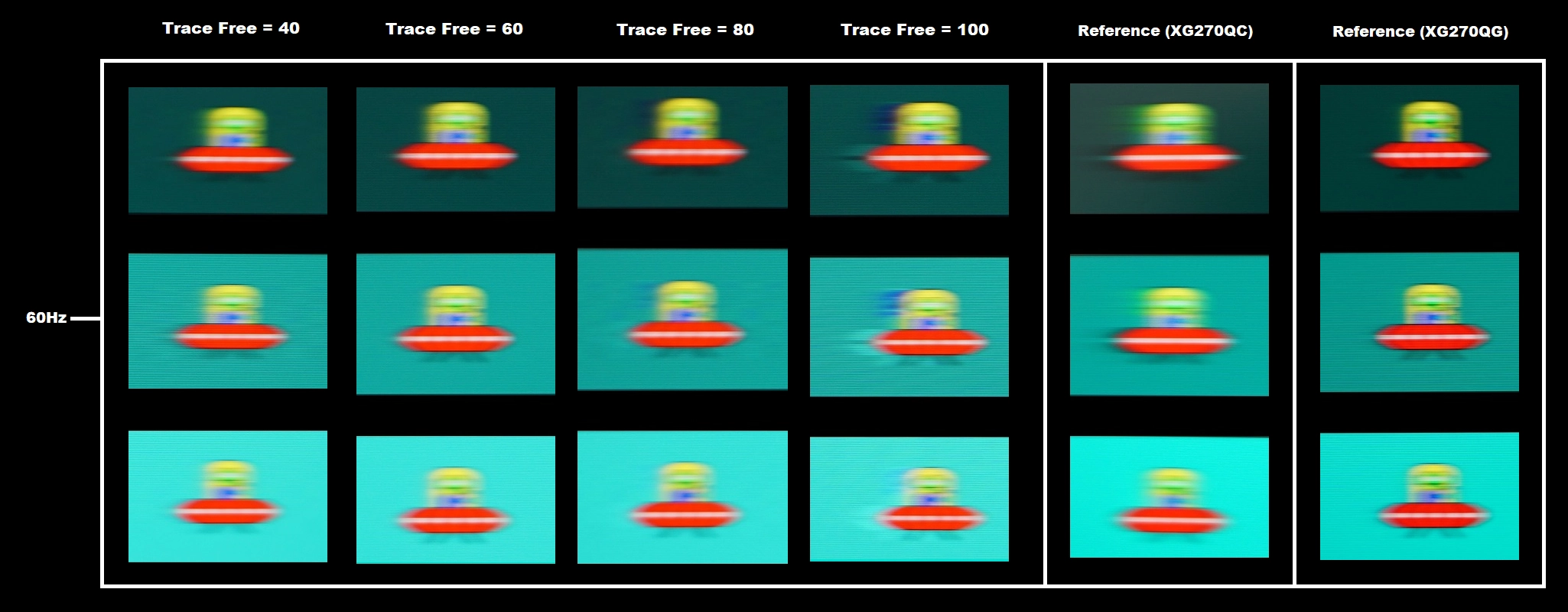
The UFOs appear quite broad and unfocused without clear internal detailing. This reflects a moderate degree of perceived blur due to eye movement. Some trailing can also be observed behind the UFOs in some cases due to weaknesses in pixel responsiveness. With TF set to ‘40’, there’s a little ‘powdery’ trailing behind the object for the dark background (top row) and a very fine dusting for the medium background (middle row). The light background (bottom row) shows a very clean performance. There’s nothing here that’s like the clearer (‘smeary’) trailing observed on the VA reference screen. Setting TF to ‘60’ cuts down on the powdery trailing and gives very little to complain about for these transitions, really. A small amount of overshoot (inverse ghosting) is visible as a faint ‘shadow’ behind the UFO for the medium background but nothing substantial. Things look similar to the fast IPS reference screen. Setting TF to ‘80’ introduces more obvious overshoot with bright and colourful trailing – this becomes very strong if ramping up TF to ‘100’. From this analysis we consider ‘60’ to be the optimal Trace Free setting and this is reflected by broader analysis. There is a bit of overshoot for some transitions not shown here (we explore this later), but it’s not extreme or widespread. If you dislike it setting TF to ‘40’ would be a good fallback. Below you can see how things appear with refresh rate increased to 75Hz.

The UFO now appears slightly narrower, reflecting a slight decrease in perceived blur due to eye movement. Not a substantial change as the refresh rate is only 1.25 times what it was before, but still an improvement. The trailing behaviour is fairly similar, with some ‘powdery’ trailing appearing slightly more pronounced. Really this just reflects the fact that the pixel response requirements for optimal performance have been raised by 25%. We again consider ‘60’ the optimal and best-balanced TF setting, without the more distinct ‘powdery’ trailing of ‘40’ and lack of stronger overshoot that creeps in at ‘80’ or beyond.
The monitor has a mode called Rapid Rendering that can be activated if Adaptive-Sync is disabled. This is a strobe backlight feature that causes the backlight to flicker at a frequency matching the refresh rate of the display – 75Hz only in this case. Sensitivity to this flickering of the backlight varies, but this is a relatively low refresh rate for a strobe backlight setting so it has strong potential to cause bother. We certainly found it unpleasant. Even if the flickering isn’t something that you find actively bothering, the flickering of the backlight can still accelerate eye fatigue. The pursuit photos below show the mode in action. Trace Free is not adjustable with this setting active, but there are two Rapid Rendering modes available: ‘Standard’ and ‘Advanced’. The ‘Advanced’ setting uses a shorter pulse width than ‘Standard’, meaning the backlight spends a relatively long period in its ‘off’ phase. The screen is therefore dimmer in comparison, but there’s a potential improvement to motion clarity with this shorter pulse width as well.
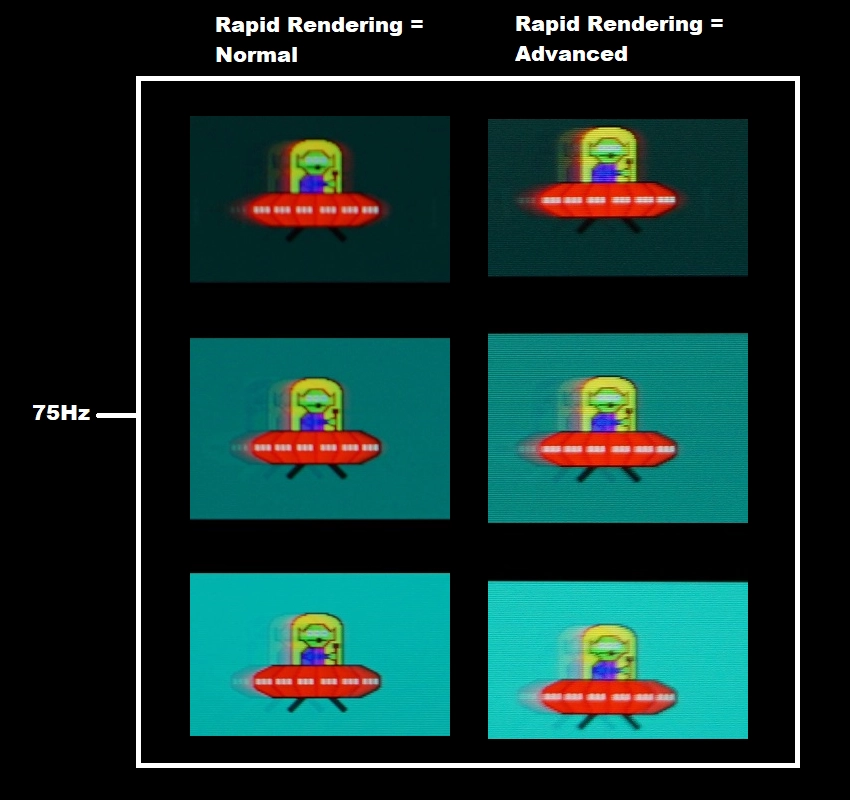
With RR active, the UFOs are significantly narrower with clearer internal detailing. There’s no real difference between the ‘Normal’ and ‘Advanced’ setting here when observed by eye, aside from the brightness. This brightness difference can cause some differences in how the images appear with both settings as the camera responds slightly differently in both cases. You can count the small notches and the segmentation of the UFO is more distinct. You can see some clear trailing behind the object, appearing fragmented with multiple repetitions due to the strobing of the backlight. For the dark background and lesser extent medium background you can also a fringe behind the UFO cockpit that’s an eye-catching and vivid red shade. It’s also visible a bit in front of the UFO for the dark background. This is due to the phosphors of the backlight and is something we observed when gaming (along with associated issues), as explored shortly. There is some overshoot visible for the medium background in particular as a ghostly final trail, whilst the earlier trail is a reasonably bold repetition of the object. The repetitions can be broadly termed ‘Strobe Crosstalk’ and can appear in different places and with different intensity depending on which section of the screen you’re observing. That’s because not all parts of the screen refresh simultaneously – you can see this behaviour in the image below.
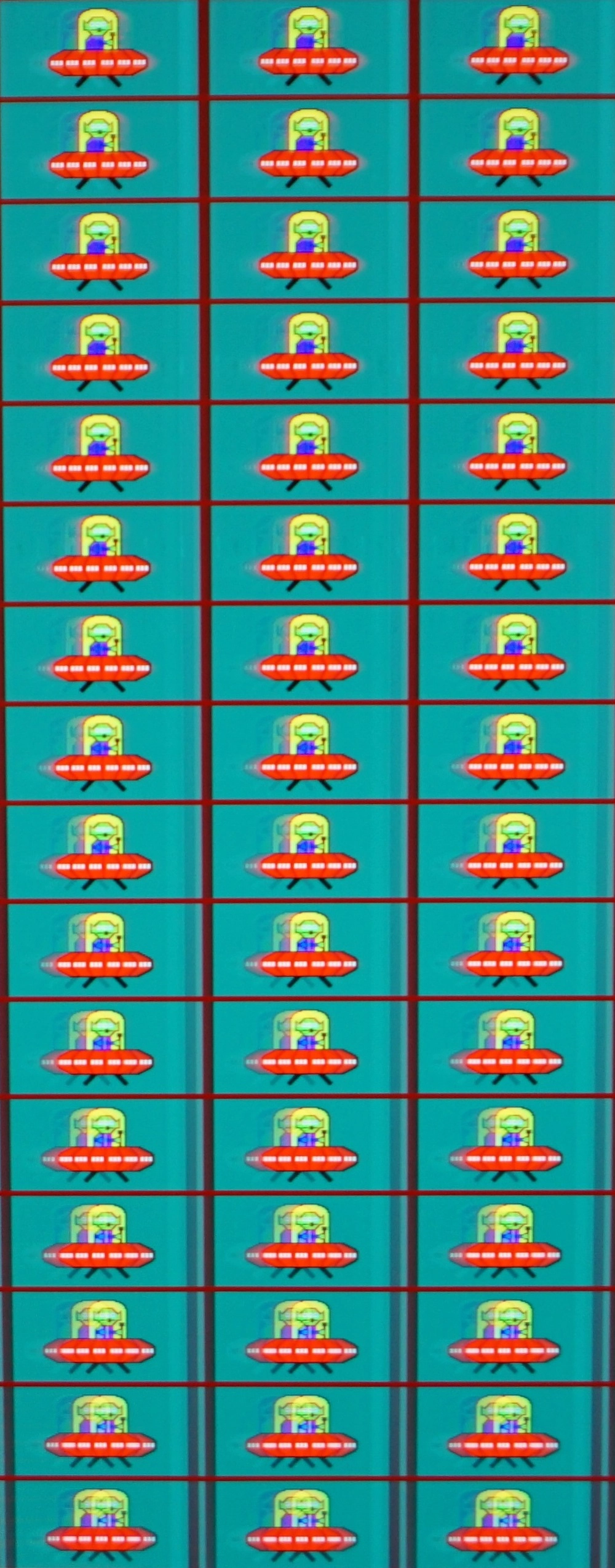
Further up the screen you can see fairly strong overshoot behind the UFO as well as a slight magenta fringe in front. Towards the centre of the screen the fringe shifts behind and a fairly distinct repetition of the object is visible. Plus a ‘shadowy’ overshoot trail behind that. The repetition becomes very bold further down the screen, eventually melding into the object so it’s about as bold and clear as the main UFO. The final overshoot trail is also distinct and inky further down the screen. We explore the implications of this clear strobe crosstalk and other factors to consider a bit later on.
Note that we will not be including a section on overclocking, as the monitor refused to display an image if set much above 75Hz.
Responsiveness in games and movies
On Battlefield V there was a moderate degree of perceived blur. This was primarily caused by eye movement and linked to the 75Hz refresh rate of the display. The bump up from 60Hz to 75Hz slightly reduced this perceived blur due to eye movement and slightly enhanced the ‘connected feel’. That’s the precision and fluidity that’s felt when interacting with the game world – this difference was marginal compared to a more significant boost. But it was still a nice little edge to have. There were no major weaknesses from pixel response times and the monitor put in a strong 75Hz performance. There was a little ‘powdery’ trailing in places, usually where darker shades were involved. But this was relatively faint and short-lived and not at all widespread. We also observed some overshoot, particularly if darker objects were set against a lighter background. Such as a medium-dark brown tree trunk against a bright daylight sky, which produced a bit of ‘halo’ trailing that was somewhat brighter than the background shade. This was not particularly bright, strong or eye-catching overshoot nor was it widespread.
We made similar observations on Shadow of the Tomb Raider. The 75Hz refresh rate again provided a slight advantage over 60Hz with respect to the perceived blur due to eye movement and ‘connected feel’. Nothing substantial but still noticeable to us. There were plenty of dark shades on this title, but a good variety of shade levels really which showcased a broad range of pixel transitions. Nothing really stood out as an obvious weakness and we found the 75Hz performance convincing. There was a touch of ‘powdery’ trailing in places and a bit of overshoot elsewhere, but this was quite minor really. We also observed video content of a range of frame rates, including ~24-30fps movie content (Netflix etc.) and 60fps YouTube content. The higher frame rate content was very similar to what we observed when gaming, so a pleasing performance overall. The lower frame rate content was also handled well. This has its fluidity limited by the frame rate itself and with this the pixel response requirements for a solid performance are low. No weaknesses were observed that could be tied to the monitor’s pixel response behaviour. Perhaps some very faint overshoot in places, but this remained well-blended and didn’t catch the eye.
As an Amazon Associate and Newegg Affiliate I earn from qualifying purchases made using the below link. Where possible, you’ll be redirected to your nearest store. Further information on supporting our work.
|
FreeSync – the technology and activating it
AMD FreeSync is a variable refresh rate technology, an AMD-specific alternative to Nvidia G-SYNC. Where possible, the monitor dynamically adjusts its refresh rate so that it matches the frame rate being outputted by the GPU. Both our responsiveness article and the G-SYNC article linked to explore the importance of these two elements being synchronised. At a basic level, a mismatch between the frame rate and refresh rate can cause stuttering (VSync on) or tearing and juddering (VSync off). FreeSync also boasts reduced latency compared to running with VSync enabled, in the variable frame rate environment in which it operates.
FreeSync requires a compatible AMD GPU such as the Radeon RX 580 used in our test system. There is a list of GPUs which support the technology here, with the expectation that future AMD GPUs will support the feature too. The monitor itself must support ‘VESA Adaptive-Sync’ for at least one of its display connectors, as this is the protocol that FreeSync uses. The ASUS PA278QV supports FreeSync via DP 1.2a and HDMI 1.4 on compatible GPUs and systems. You need to make sure ‘Adaptive-Sync’ is set to ‘ON’ in the ‘System Setup’ section of the OSD. On the GPU driver side recent AMD drivers make activation of the technology very simple and something that usually occurs automatically. You should ensure the GPU driver is setup correctly to use FreeSync, so open ‘AMD Radeon Software’, click ‘Settings’ (cog icon towards top right) and click on ‘Display’. You should then ensure that the first slider, ‘Radeon FreeSync’ is set to ‘Enabled’ as shown below. The top image shows the monitor connected by DP and the bottom image by HDMI.
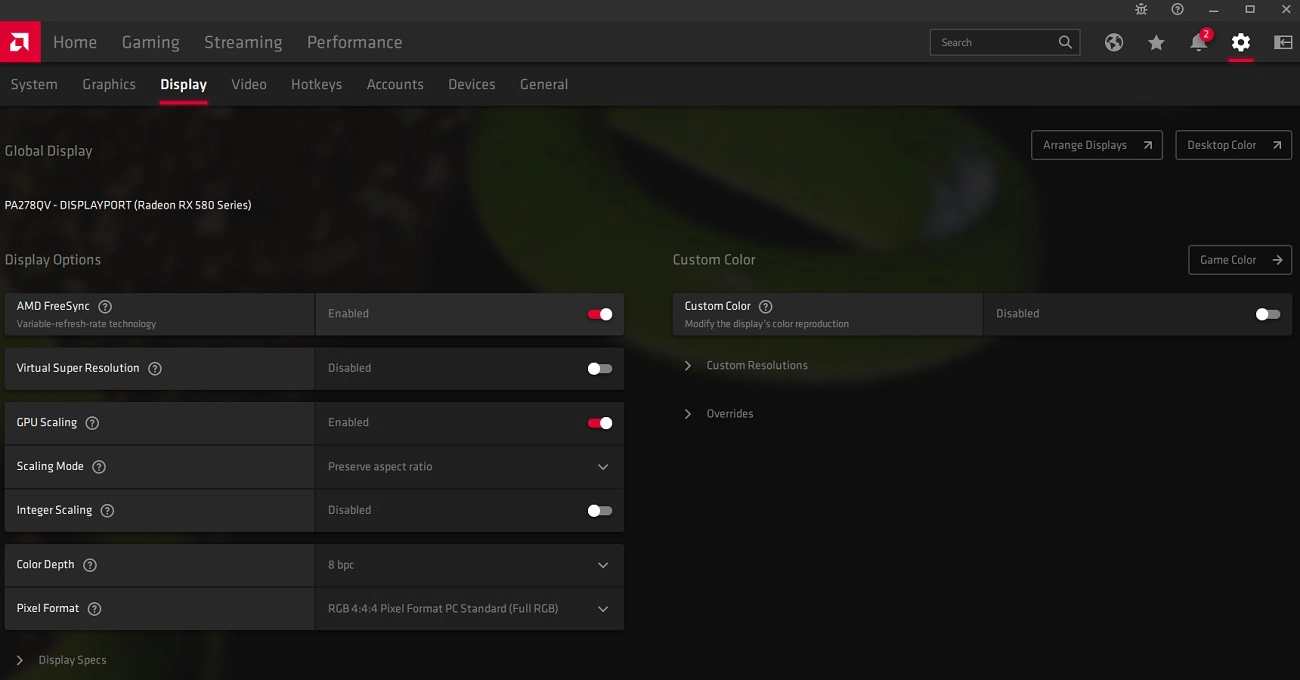
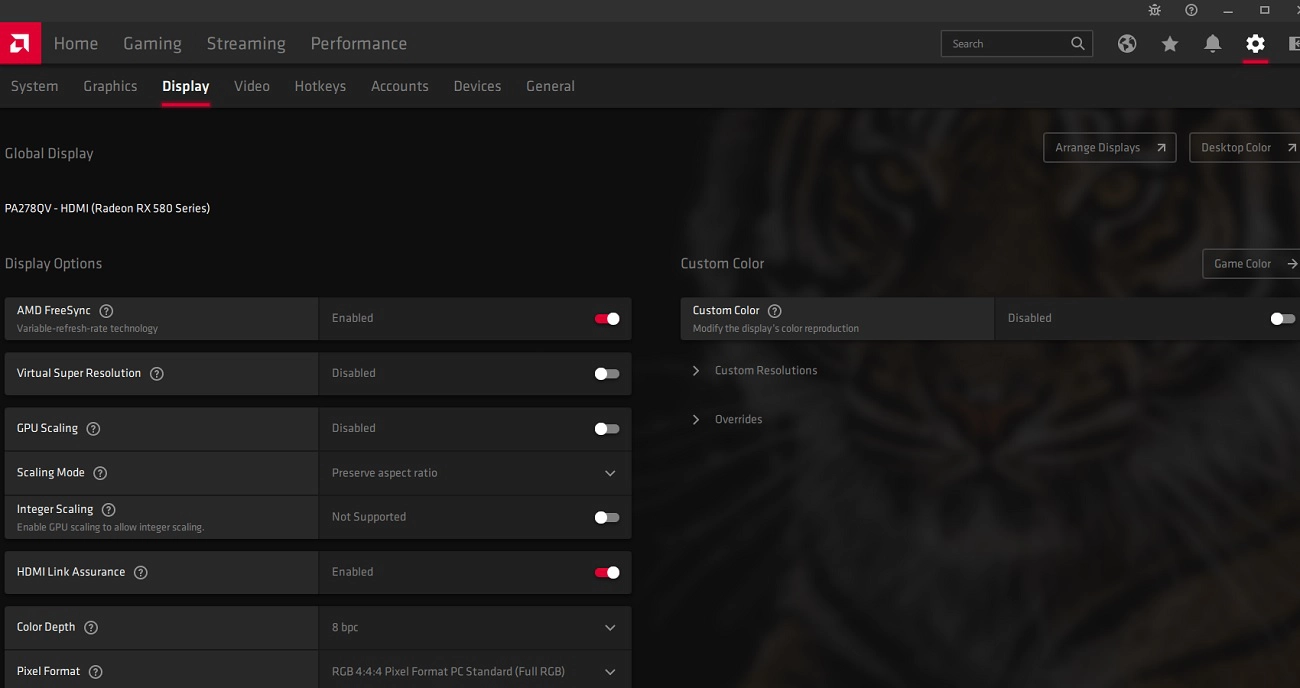
The ASUS supports a variable refresh rate range of 48 – 75Hz. That means that if the game is running between 48fps and 75fps, the monitor will adjust its refresh rate to match. When the frame rate rises above 75fps, the monitor will stay at 75Hz and the GPU will respect your selection of ‘VSync on’ or ‘VSync off’ in the graphics driver. With ‘VSync on’ the frame rate will not be allowed to rise above 75fps, at which point VSync activates and imposes the usual associated latency penalty. With ‘VSync off’ the frame rate is free to climb as high as the GPU will output (potentially >75fps). LFC (Low Frame Rate Compensation) is not supported by this monitor, as that requires the upper limit (ceiling) to be at least 2x the lower limit (floor) of FreeSync operation. FreeSync is therefore deactivated if the frame rate falls below 48fps, with the monitor then respecting your choice of VSync and presenting you with either stuttering (VSync on) or tearing (VSync off).
To configure VSync, open ‘AMD Radeon Software’. Click ‘Settings’ (cog icon towards top right) and click ‘Graphics’. The setting is listed as ‘Wait for Vertical Refresh’. This configures it globally, but if you wish to configure it for individual games click ‘Game Graphics’ towards the top right. The default is ‘Off, unless application specifies’ which means that VSync will only be active if you enable it within the game itself, if there is such an option. Such an option does usually exist – it may be called ‘sync every frame’ or something along those lines rather than simply ‘VSync’. Most users will probably wish to enable VSync when using FreeSync to ensure that they don’t get any tearing. You’d therefore select either the third or fourth option in the list, shown in the image below. Above this dropdown list there’s a toggle for ‘Radeon Enhanced Sync’. This is an alternative to VSync which allows the frame rate to rise above the refresh rate (no VSync latency penalty) whilst potentially keeping the experience free from tearing or juddering. This requires that the frame rate comfortably exceeds the refresh rate, not just peaks slightly above it. We won’t be going into this in detail as it’s a GPU feature rather than a monitor feature.

Some users prefer to leave VSync enabled but use a frame rate limiter set a few frames below the maximum supported (e.g. 72fps) instead, avoiding any VSync latency penalty at frame rates near the ceiling of operation or tearing from frame rates rising above the refresh rate. The refresh rate displayed towards the top right of the OSD will reflect the frame rate of the content at the time you enter the OSD, if FreeSync is active and you’re within the VRR (Variable Refresh Rate) window. Finally, it’s worth noting that FreeSync only removes stuttering or juddering related to mismatches between frame rate and refresh rate. It can’t compensate for other interruptions to smooth game play, for example network latency or insufficient system memory. Some game engines will also show stuttering (or ‘hitching’) for various other reasons which won’t be eliminated by the technology.
FreeSync – the experience
As usual we tested various game titles using AMD FreeSync and found the experience similar in all cases. Any issues affecting one title but not another suggests a game or GPU driver issues rather than a monitor issue. For simplicity we’ll simply focus on Battlefield V as an example for this section. The graphics options allowed us to test the full VRR range of the monitor. With settings turned up a bit we commonly observed slight dips below 75fps. Without a VRR technology like FreeSync, such dips would cause obvious stuttering (VSync on) or tearing and associated juddering (VSync off). Obvious to us and others sensitive to such things, at least. These issues tend to be more noticeable at reasonably low refresh rates such as this, so it’s certainly nice having these interruptions removed.
As frame rate dropped further, because action intensified or due to graphics settings used, we noticed a drop off in ‘connected feel’ and increase in perceived blur linked to the drop in frame rate. This isn’t something FreeSync can help with – but the lack of tearing and stuttering from frame and refresh rate mismatches was nice. As refresh rate reduced the overshoot which was quite modest at 75Hz become more pronounced. It wasn’t ever extreme nor was it particularly widespread, so we didn’t really find it distracting or bothersome. Sensitivity varies and if you find it bothersome switching ‘Trace Free’ to ‘40’ should prove beneficial, which worked quite well still. Particularly towards the lower end of the VRR range. When frame rate dropped below 48fps the technology deactivated and tearing or stuttering resumed, depending on VSync status. LFC (Low Frame Rate Compensation) is not used as that would require the ceiling of operation is at least twice the floor of operation.
Nvidia Adaptive-Sync (‘G-SYNC Compatible’)
As noted earlier, AMD FreeSync makes use of Adaptive-Sync technology on a compatible monitor. As of driver version 417.71, users with Nvidia GPUs (GTX 10 series and newer) and Windows 10 can also make use of this Variable Refresh Rate (VRR) technology. When a monitor is used in this way, it is something which Nvidia refers to as ‘G-SYNC Compatible’. Some models are specifically validated as G-SYNC compatible, which means they have been specifically tested by Nvidia and pass specific quality checks. With the PA278QV, you need to connect the monitor up via DisplayPort and enable ‘Adaptive Sync’ in the ‘System Setup’ section of the OSD. This enables Adaptive-Sync on the monitor and will unlock the appropriate settings in Nvidia Control Panel. When you open up Nvidia Control Panel, you should then see ‘Set up G-SYNC’ listed in the ‘Display’ section. Ensure the ‘Enable G-SYNC, G-SYNC Compatible’ checkbox and ‘Enable settings for the selected display model’ is checked as shown below. Press OK, then turn the monitor off then on again so that it re-establishes connection – the technology should now be active. The image below is for a different model, but the model number is the only information on the page that differs.
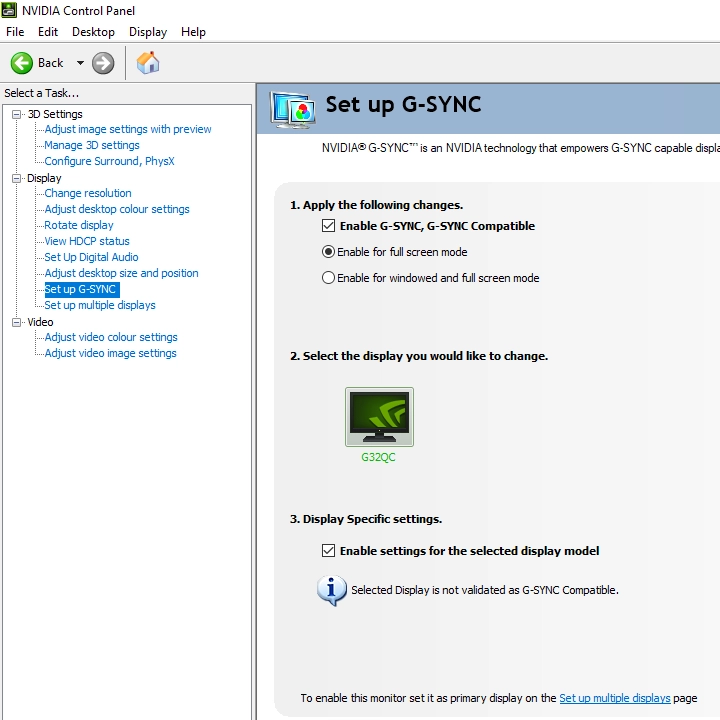
You will also see in the image above that it states: “Selected Display is not validated as G-SYNC Compatible.” This means Nvidia hasn’t specifically tested and validated the display, not that it doesn’t work. Indeed the technology did work. It delivered an experience that was very similar to FreeSync, getting rid of tearing and stuttering in much the same way as frame rate fluctuated within its window of operation. A slight difference was that the floor of operation, at least with our GTX 1080 Ti, was 52Hz (52fps) rather than 48Hz (48fps). Not a difference worth stressing about in our view, but worth noting nonetheless. Our suggestions regarding use of VSync also apply, but obviously you’re using Nvidia Control Panel rather than Radeon Settings to control this. The setting is found in ‘Manage 3D settings’ under ‘Vertical sync’, where the final option (‘Fast’) is equivalent to AMD’s ‘Enhanced Sync’ setting. You’ll also notice ‘G-SYNC Compatible’ listed under ‘Monitor Technology’ in this section, as shown below. Make sure this is selected (it should be if you’ve set everything up correctly in ‘Set up G-SYNC’).
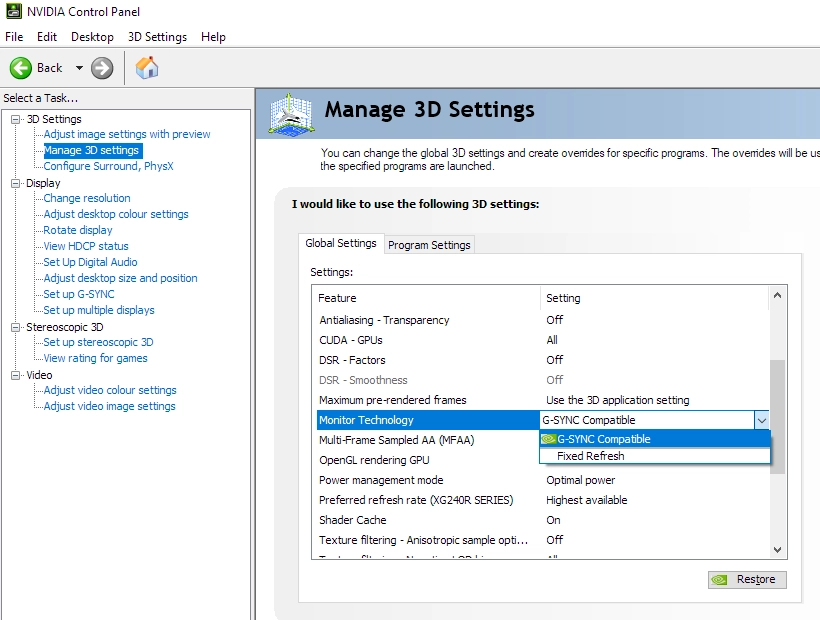
Finally, remember that the refresh rate displayed towards the top right of the OSD will reflect the frame rate of the content at the time you enter the OSD, if Adaptive-Sync is in use and you’re within the VRR window.
Rapid Rendering
We’ve already introduced the Rapid Rendering feature, its principles of operation and how it performs using specific tests. When using Rapid Rendering or any strobe backlight feature, it’s vital that your frame rate matches the refresh rate of the display exactly. Otherwise you’re left with very clear stuttering or juddering. This is because there’s very little perceived blur due to eye movement to mask it. As with most strobe backlight technologies, you can’t use Adaptive-Sync at the same time as Aim Stabilizer. You must be running the monitor at 75Hz and have ‘Adaptive Sync’ disabled in the ‘System Setup’ section of the OSD to activate the feature. We observed a few game titles using this feature but will just focus on Battlefield V running at a constant 75fps at 75Hz. We had the feature set to ‘Normal Mode’ as although this was dim, the ‘Advanced Mode’ was even dimmer. Brightness aside, our observations were largely similar even using ‘Advanced Mode’. This feature did significant cut down on perceived blur due to eye movement so in some respects motion on the screen was clearer. Objects didn’t break up into a blur even during rapid motion as they do during the normal sample and hold operation of the monitor.
We found the feature uncomfortable to use and there were plenty of visual disturbances when using it. The fact the screen was flickering at 75Hz was bothersome in itself. We also frequently observed flashes of colour such as cyan and magenta as we scanned our eyes across the screen or even moved them a short distance. The strobe crosstalk we observed using the UFO Motion Test for ghosting earlier was there in full effect. There were clear repetitions throughout the screen either in front of or behind objects. These were extremely strong and off-putting lower down the screen, but quite distinct centrally as well. It included very eye-catching colourful elements with a clear magenta or at times cyan tint. Put all of this together and this wasn’t a setting we liked to use for more than about 10 minutes. Some people may enjoy the benefits of this in terms of making it easier to track and engage enemies. Or they may have a specific work-purpose that benefits from the reduced perceived blur due to eye movement. It’s an interesting addition and not one you often see on 75Hz models, but it’s far from a ‘clean’ or comfortable experience.
Interpolation and upscaling
You may want to run the monitor at a lower resolution than the native 2560 x 1440, perhaps for better performance or to use a device such as a games console which doesn’t support native WQHD output. The monitor supports scaling functionality via any of its display inputs. As noted in the features and aesthetics section, a range of refresh rates (up to 60Hz) are supported at the Full HD resolution, whilst a ‘4K’ UHD upscaling mode is also offered. To ensure the monitor rather than GPU is handling the scaling process, you need to make sure the GPU driver is set up correctly. For AMD GPU users the monitor will handle the scaling by default, when gaming at non-native resolutions. Nvidia users should open the Nvidia Control Panel and navigate to ‘Display – Adjust desktop size and position’. They should ensure that ‘No Scaling’ is selected and ‘Perform scaling on:’ is set to ‘Display’ as shown below.

Considering the 1920 x 1080 (‘1080p’ Full HD) resolution, the monitor’s interpolation process provided a moderate amount of softening. This could be counteracted by adjusting ‘Sharpness’ in the ‘Image’ section of the OSD. We liked the balance struck at a setting of ‘30’, although everyone will have their own preferences. The image didn’t appear as it would natively on a Full HD screen of this size, but it didn’t have the obvious soft appearance that it did with the default sharpness level of ‘0’. Some elements appeared slightly filtered or oversharpened, but overall it made the monitor quite useable at the Full HD resolution and certainly better than some monitor interpolation processes we’ve come across.
As usual, if you’re running the monitor at 2560 x 1440 and viewing 1920 x 1080 content (for example a video over the internet or a Blu-ray, using movie software) then it is the GPU and software that handles the upscaling. That’s got nothing to do with the monitor itself – there is a little bit of softening to the image compared to viewing such content on a native Full HD monitor, but it’s not extreme and shouldn’t bother most users.
Video review
The video below shows the monitor in action. The camera, processing done and your own screen all affect the output – so it doesn’t accurately represent what you’d see when viewing the monitor in person. It still provides useful visual demonstrations and explanations which help reinforce some of the key points raised in the written piece.
Timestamps:
Features & Aesthetics
Contrast
Colour reproduction
Responsiveness (General)
Responsiveness (Adaptive-Sync)
Conclusion
The ASUS PA278QV is designed with colour accuracy in mind, as a member of the ProArt series. The monitor was well-built with good ergonomic flexibility, with a sensible home-office aesthetic. The resolution and screen size combination is one we’re very familiar with and is indeed a very popular one – and for good reason, it works well for a multitude of purposes. The monitor was nicely calibrated with respect to gamma and offered excellent flexibility in the OSD to adjust the gamma and colour channels. Following some slight adjustment to the colour channels and the usual brightness reduction the image was rich, natural and well-balanced. The colour gamut extended just a little beyond sRGB, providing faithful reproduction of sRGB content without obvious oversaturation or indeed undersaturation.
The contrast perform was much in-line with our expectations and indeed the panel specifications. Close to 1000:1 static contrast with a moderate but typical level of ‘IPS glow’ that ate away at some atmosphere in dark scenes. The screen surface was quite agreeable, with a light matte finish that preserved vibrancy and clarity relatively well. Plus a relatively smooth finish that kept brighter content free from any real graininess. Gamma consistency was strong, so detail level in dark scenes were appropriately maintained throughout the screen. The monitor also put in a solid 75Hz performance, providing a slight but not revolutionary edge compared to 60Hz models. The pixel responses were well-tuned with only a bit of overshoot and small amount of ‘powdery’ trailing for a slim number of transitions. The monitor also provided Adaptive-Sync which worked as it should on both our AMD (FreeSync) and Nvidia GPUs (‘G-SYNC Compatible Mode’).
Overall, we feel the monitor fits its brief very well. Colour reproduction within the sRGB colour space was its main strength, whilst it offers respective responsiveness and decent contrast on top. The monitor was also well built with excellent ergonomics and good OSD flexibility. Whilst it doesn’t offer support for extended colour spaces, high (triple-digit) refresh rates or HDR it’s certainly a competitively priced, well thought-out and capable all-rounder.
The bottom line; a solid all-round performer with a nod towards strong sRGB colour performance, respectable responsiveness and excellent ergonomics.
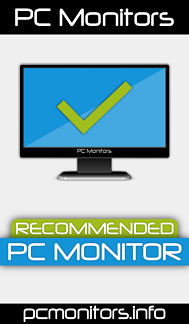
| Positives | Negatives |
| Rich and natural colour output with strong colour and gamma consistency from the IPS-type panel | No extended gamut or HDR support |
| Decent contrast, in-line with expectations. A light matte screen surface with smooth finish keeping the image free from obvious layering or graininess | A moderate amount of ‘IPS glow’ affects the detail and atmosphere for darker content |
| Fairly low input lag and a competent 75Hz performance, Adaptive-Sync works well on both AMD and Nvidia GPUs | Minor pixel response time weaknesses in places (slight ‘powdery’ trailing and overshoot) |
| Excellent ergonomics, good build quality and competitive pricing with a comfortable resolution and pixel density | Some may prefer a joystick or more comprehensive software for OSD control |
As an Amazon Associate and Newegg Affiliate I earn from qualifying purchases made using the below link. Where possible, you’ll be redirected to your nearest store. Further information on supporting our work.
|

